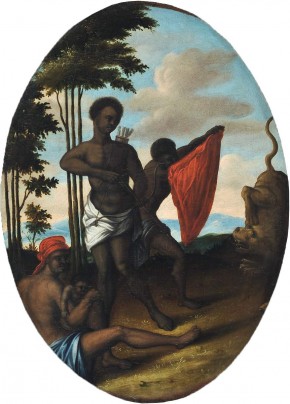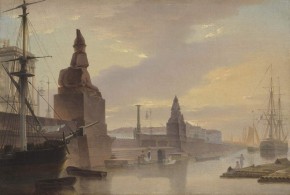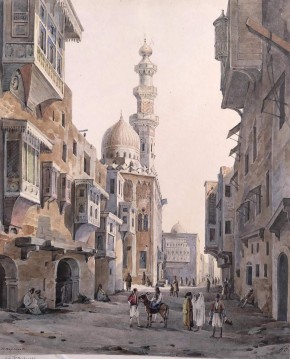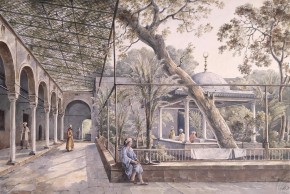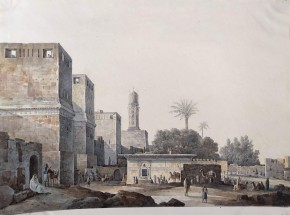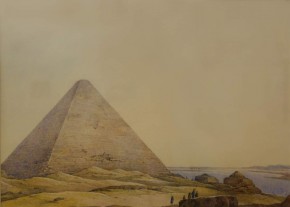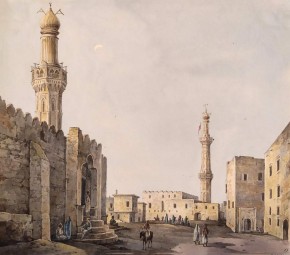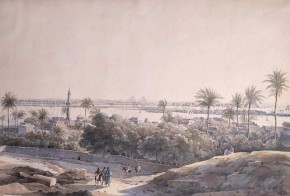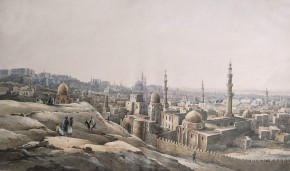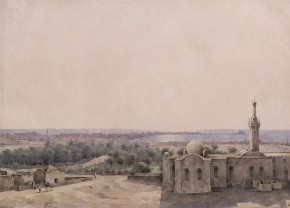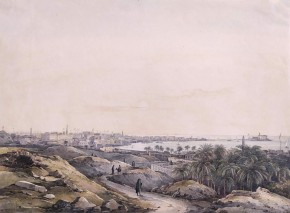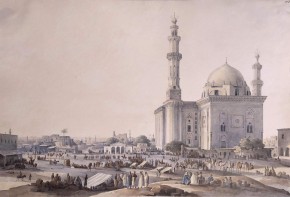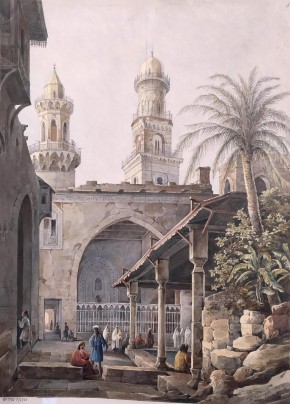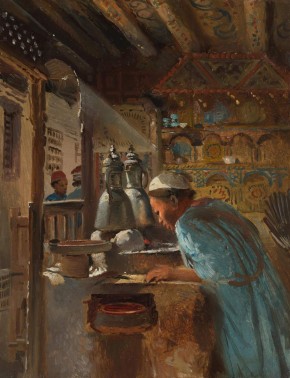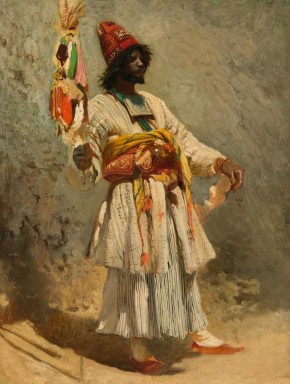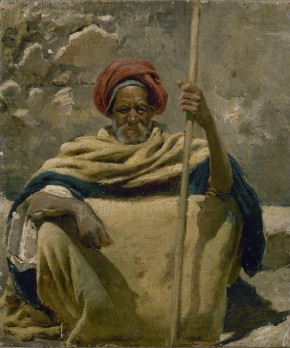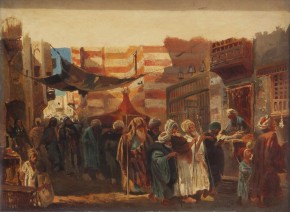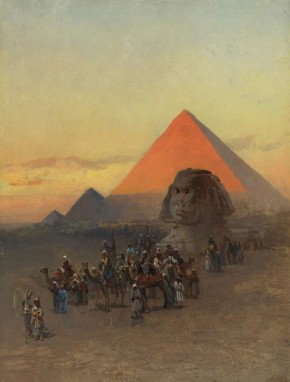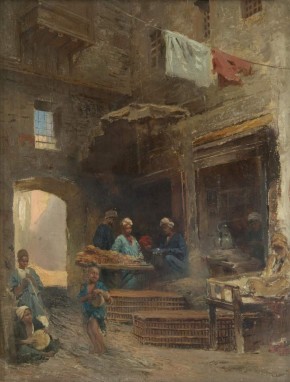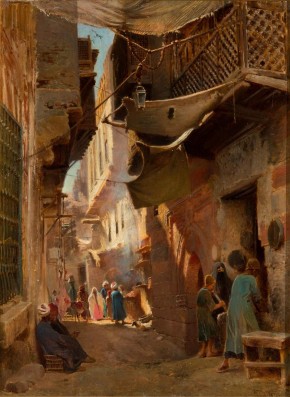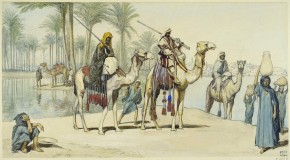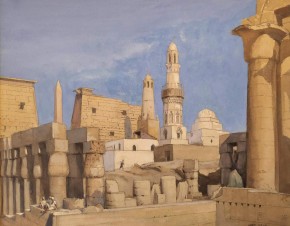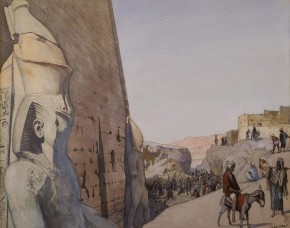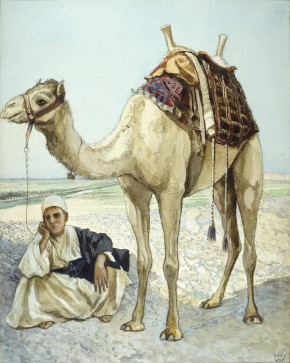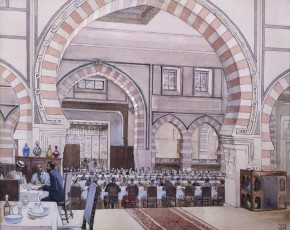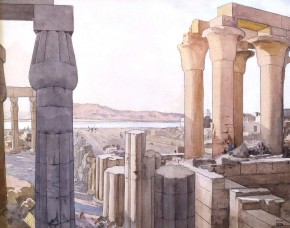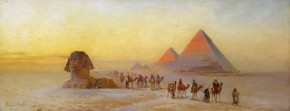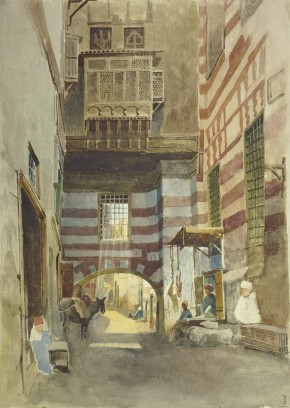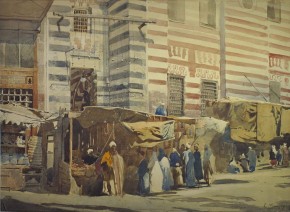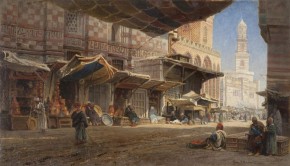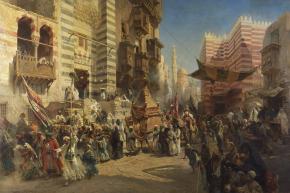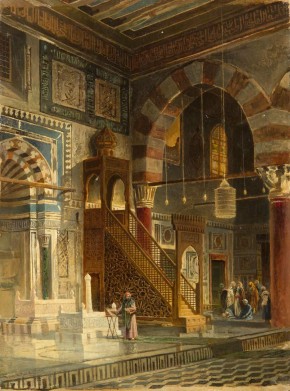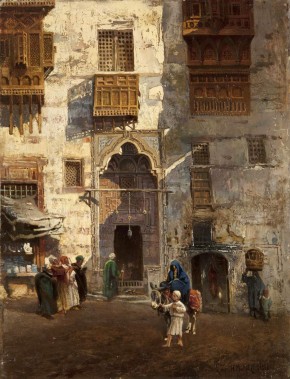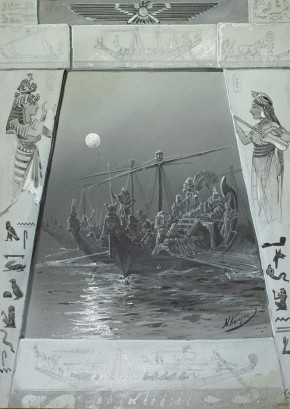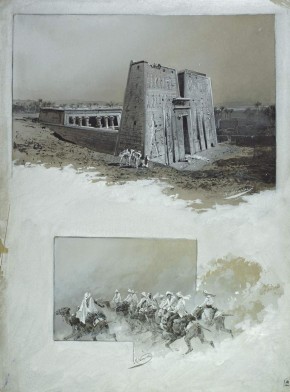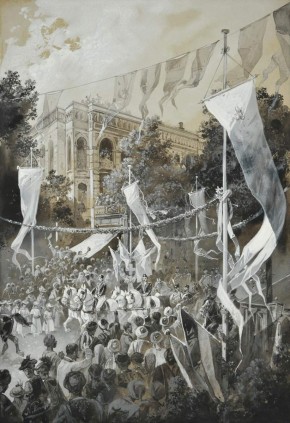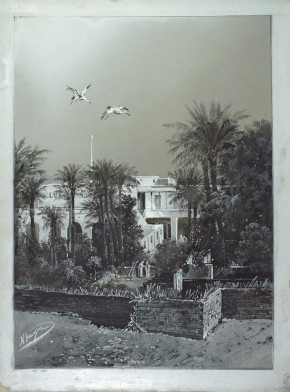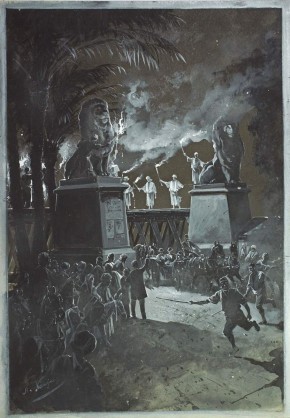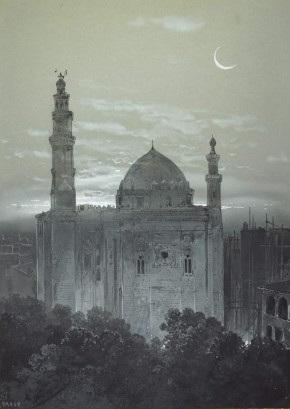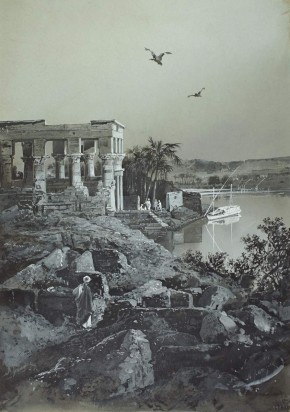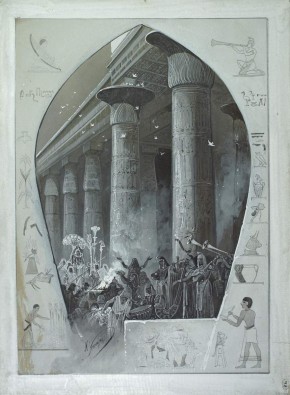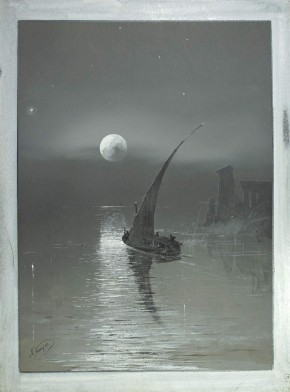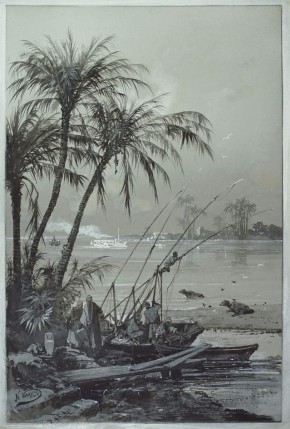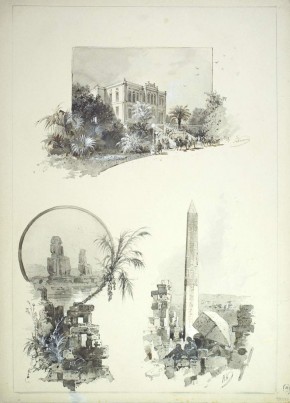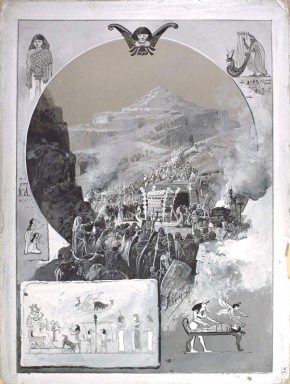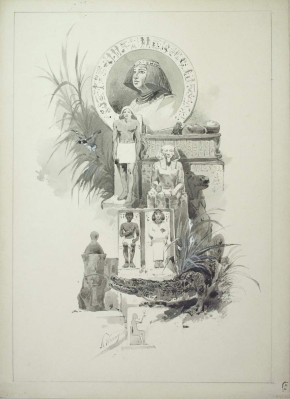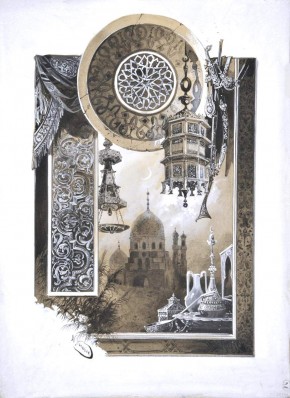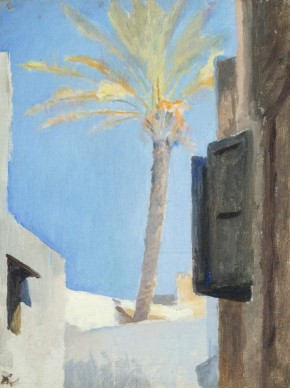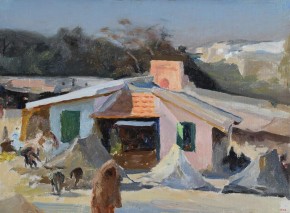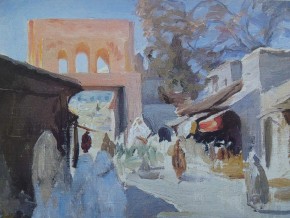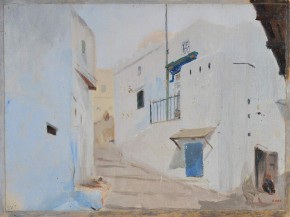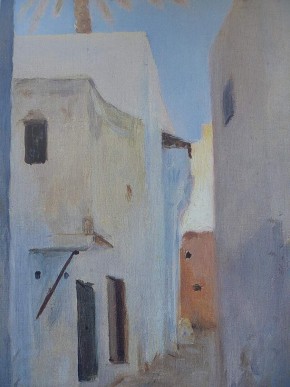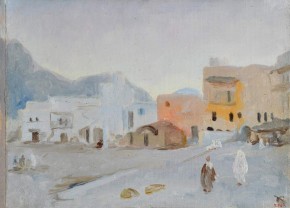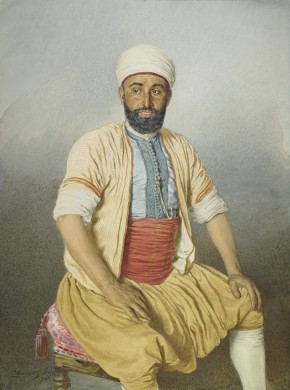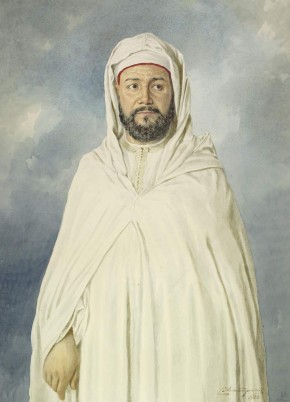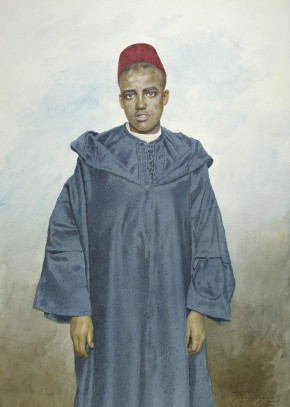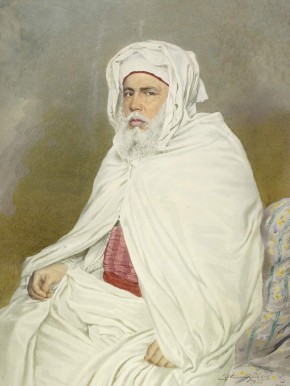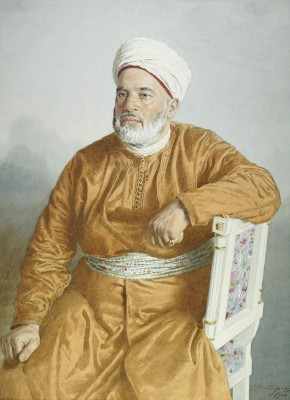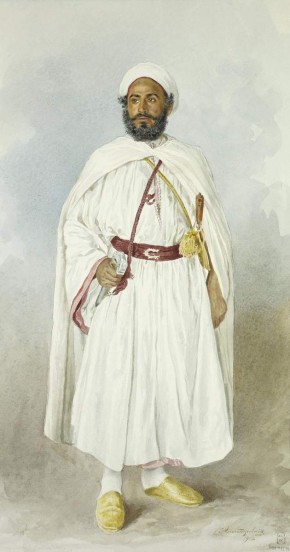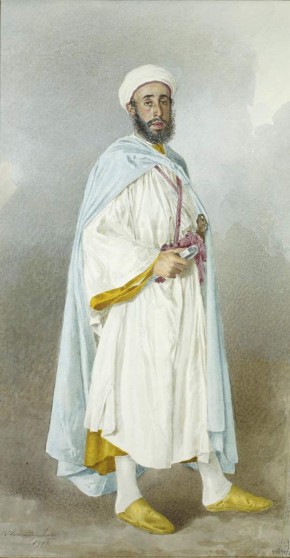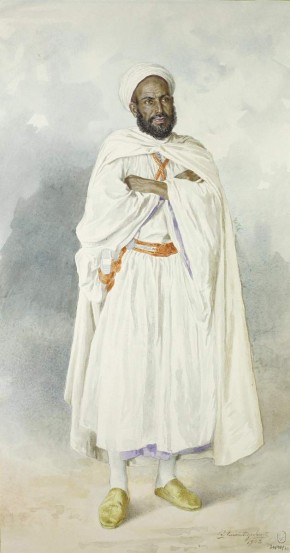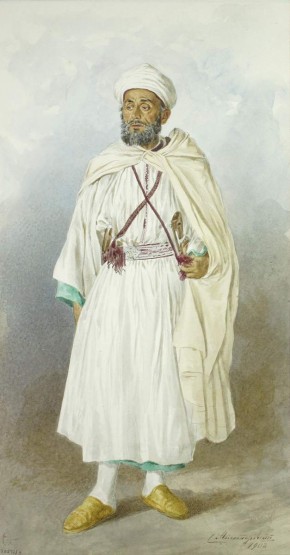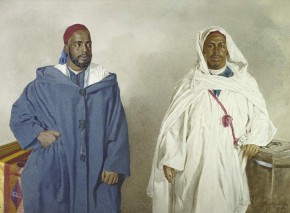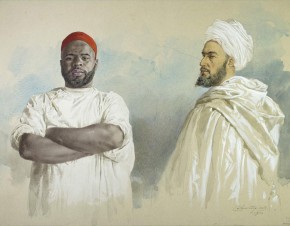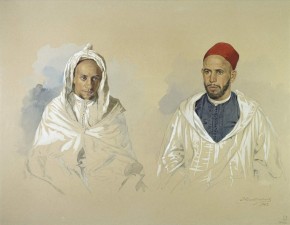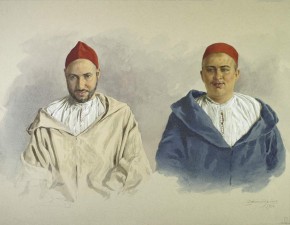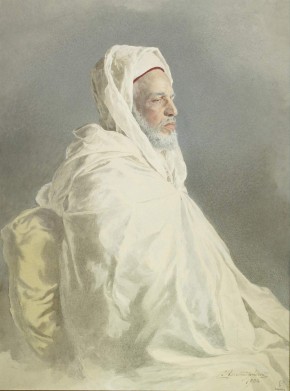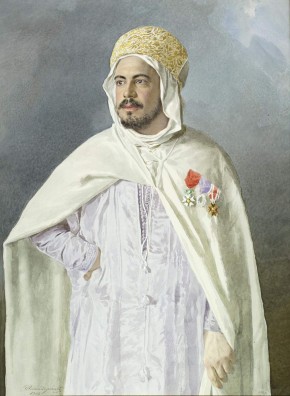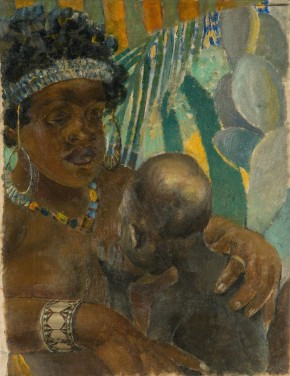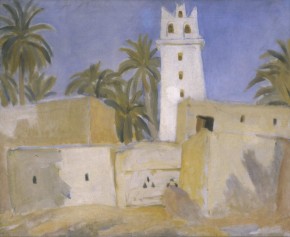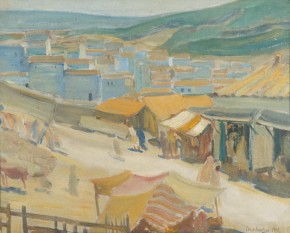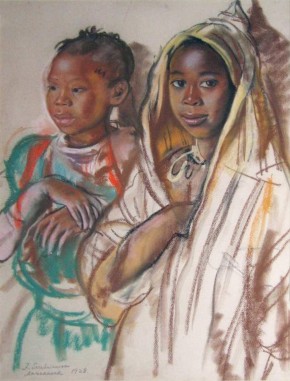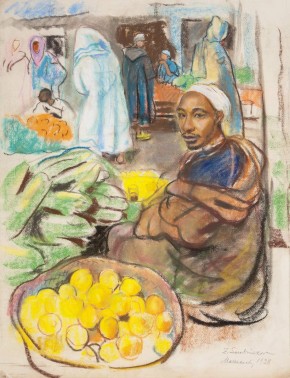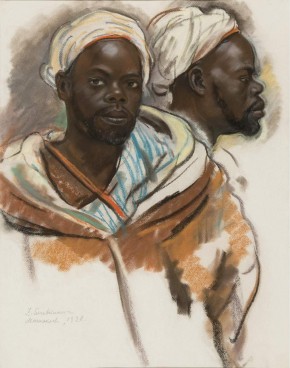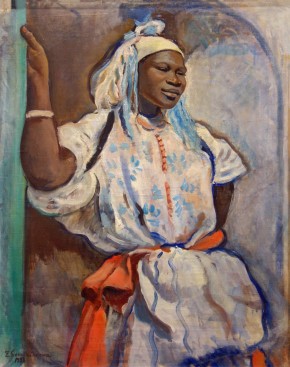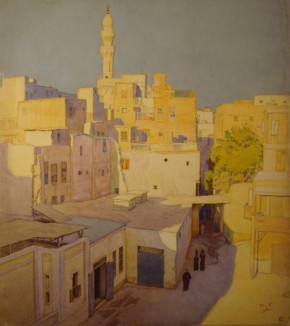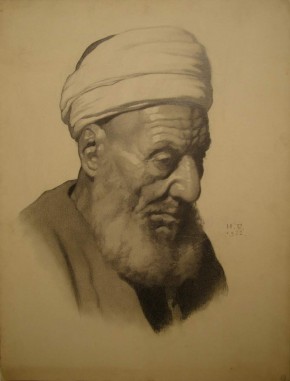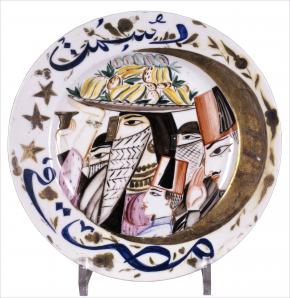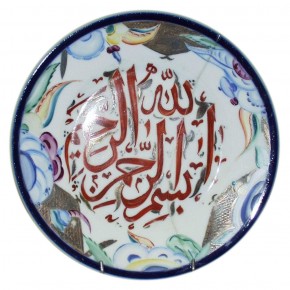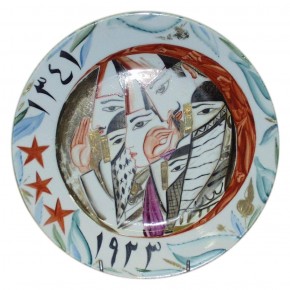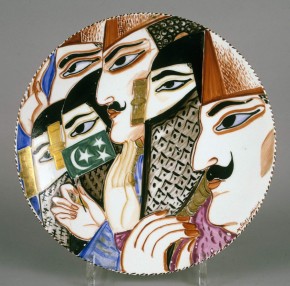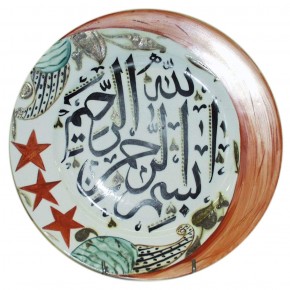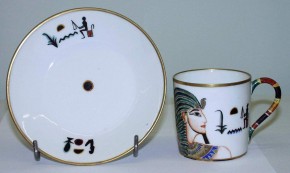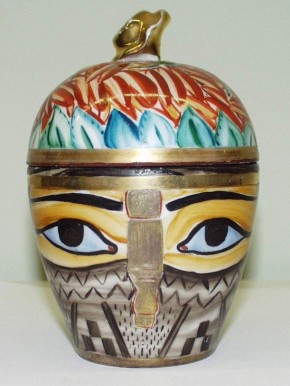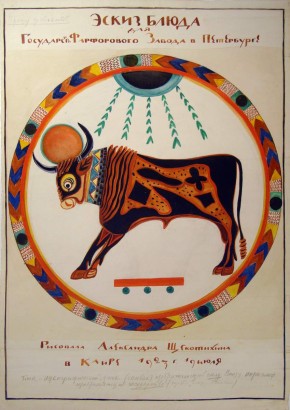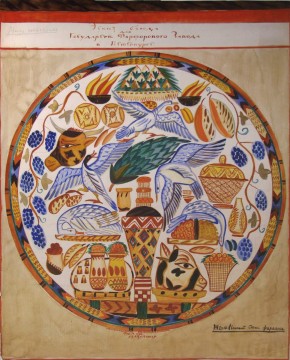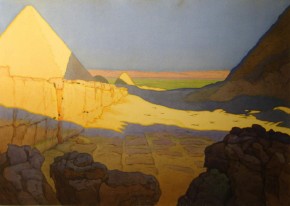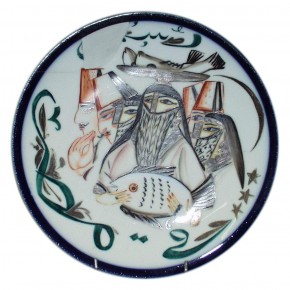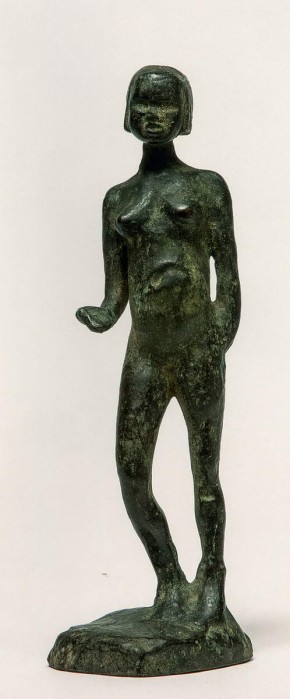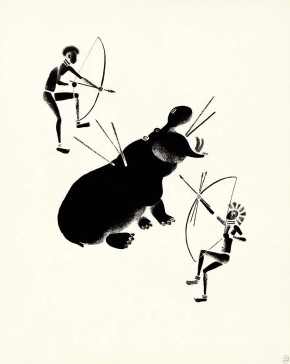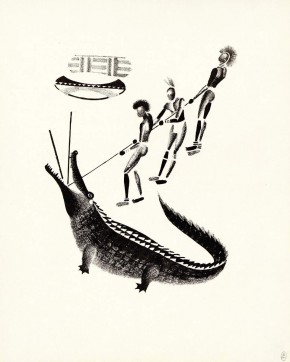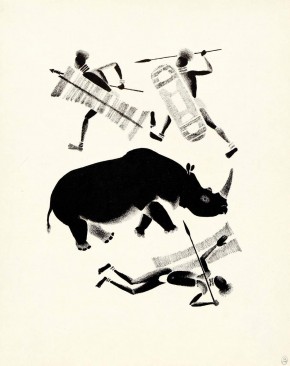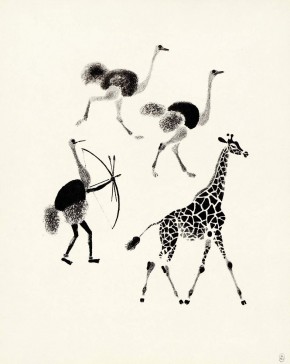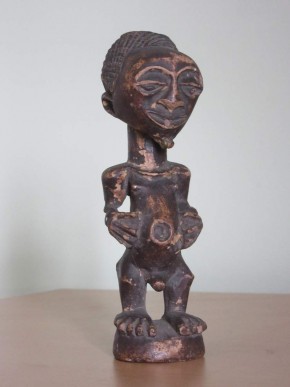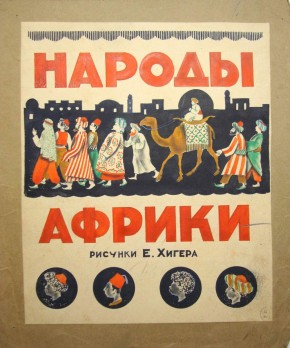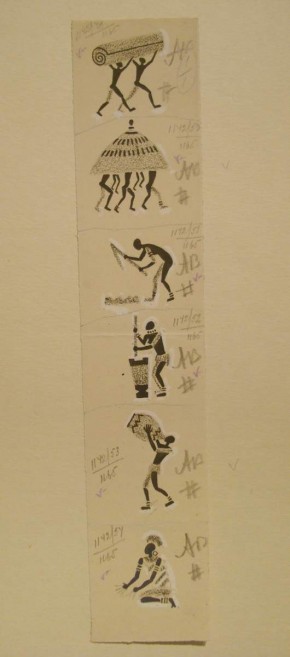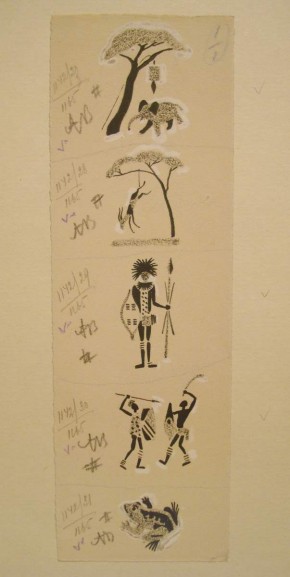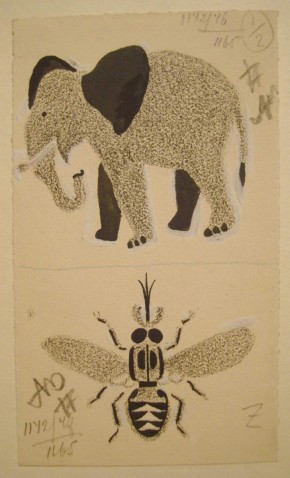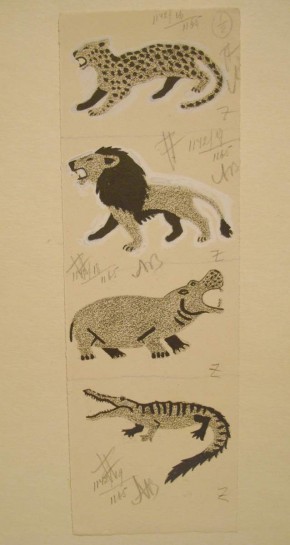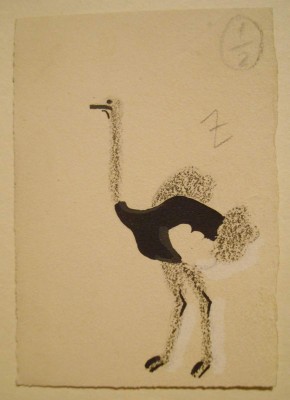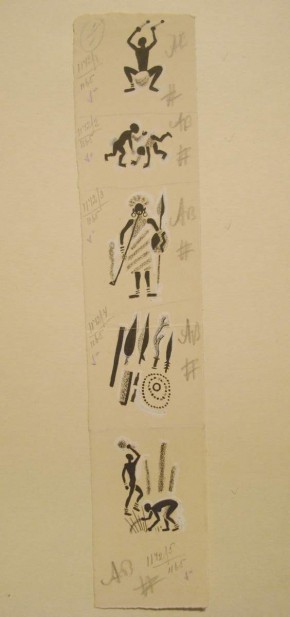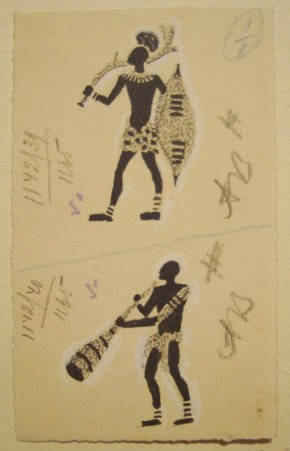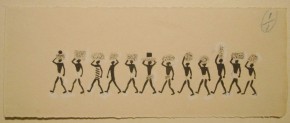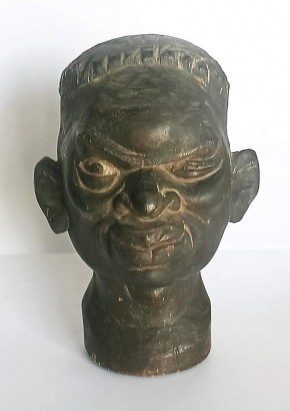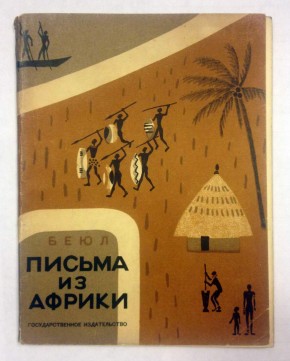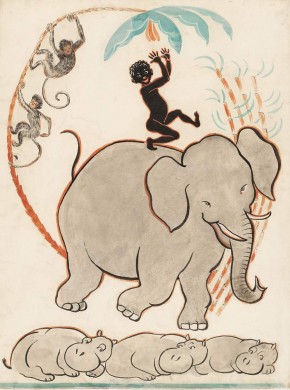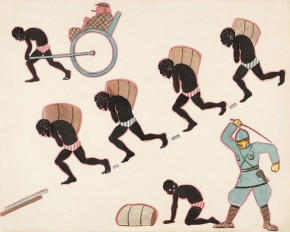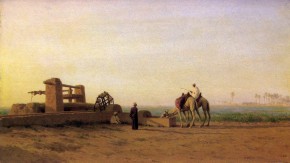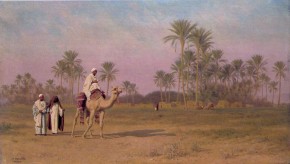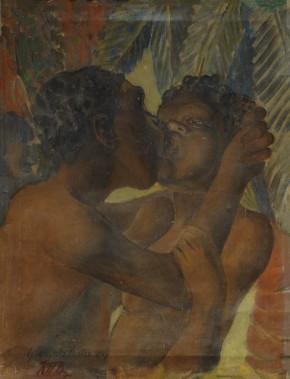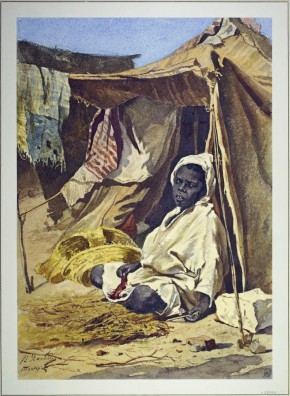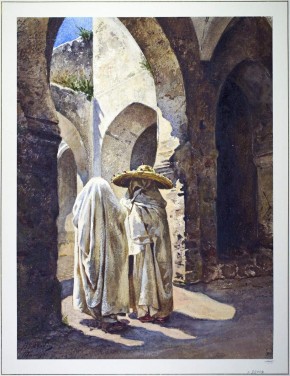Advanced search collections
Africa in the Works of Russian Artists
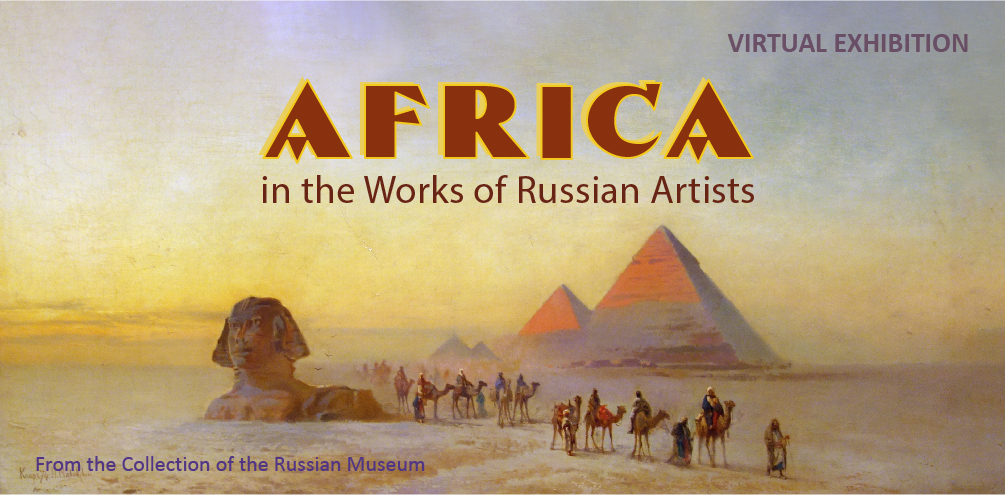
Russian Museum's virtual exhibition brings together more than 100 works from the collection of the Russian Museum, created by Russian artists on the African continent or dedicated to Africa, its history, inhabitants and cultural heritage of Ancient Egypt.
Africa has excited the imagination of travellers, explorers and, of course, artists, for centuries. This remote and mysterious continent has not lost its magical appeal for creative souls. It was visited many times in the 19th and 20th centuries by Russian painters, graphic artists and sculptors. For some, their experience of Africa was limited to a single voyage, while others returned repeatedly to their favourite places, sometime broadening the scope of their journeys in search of new impressions, motifs and themes for their art. There were also those who, for a variety of reasons, made journeys only in their imagination, paying tribute, for example, to the passion for African art that spread through Europe at the beginning of the 20th century.
The Russian Museum maintains a small but interesting and impressive collection of works related to or dedicated to Africa. Some of them, primarily drawings, sketches and studies, were made during trips to the continent and later served as a source for large easel works created by the artists upon their return.
Egypt and the Maghreb countries were the African territories most explored by Russian artists in the 19th and early 20th centuries. Indeed, the Russian “iconography” of the “black continent” began with the depiction of ancient Egyptian monuments and landscapes. A series of watercolours by the brothers Nikanor (1805–1879) and Grigory (1802–1865) Chernetsov that accurately document what they saw on their travels are the earliest works on display at the exhibition. In 1842, the artists spent one and a half autumn months in Egypt travelling along the Nile and in the desert, exploring the sights and the country’s unusual natural features. The brothers mainly focused on ancient Egyptian monuments and cities – Alexandria, Cairo, Luxor… The graphic works by Prince Grigory Gagarin (1810–1893) also display the same aspiration for precision and documentary approach. The motifs and themes in the Chernetsovs’ watercolours are somewhat similar to Gagarin’s, as is their fascination with ancient monuments. Gagarin’s work, however, focuses more on the everyday life of the Arabs and their nomadic way of life.
The genre-based approach – an interest in local people and their traditions, unusual individuals – was increasingly evident in the works of artists of the subsequent generation, such as Konstantin (1839–1915) and Nikolai (1841–1886) Makovsky and Valery Jacobi (1834–1902), who frequently visited North Africa in the 1870s and 1880s. The most famous and significant Russian artist of the second half of the 19th century who visited Egypt and its neighbouring countries was Konstantin Makovsky. His picturesque canvases, such as Handing over of the Sacred Carpet in Cairo (1876, State Russian Museum), as well as his watercolours, which he painted in a broad and free manner, filled with the sun and heat, became the most vivid reflection of Orientalism in Russian fine art of the 1870s.
It was not always necessary to travel to a remote country to meet African people. The Russian Museum possesses a unique collection of watercolour portraits of the members of the first Moroccan Embassy to Russia, which paid an official visit to St Petersburg and Moscow in the summer of 1901. The museum inventory from that time mentions 20 watercolours that were painted by Stepan Alexandrovsky (1842–1906) from life during this visit.
Artists’ trips to North Africa became more frequent in the late 19th century, and especially in the first decades of the 20th century. In the late 1890s – 1910s, Jan Ciągliński (1858–1912) and Hugo Backmansson (1860–1953) travelled repeatedly to Tunisia and Morocco. Kuzma Petrov-Vodkin (1878–1939) spent several months in Morocco and Algeria in 1907. Zinaida Serebryakova (1884–1967) visited Morocco in the mid-1920s – early 1930s. This flow of new impressions also revealed their artistic talents in painting, inspired by colour.
Later, in the 1920s and 1930s, the interest in Black African art and the desire to understand its special language were reflected in the works of Soviet sculptors and graphic artists, such as the sculptural works by Vera Isayeva (1898–1960), as well as her illustrations for the children’s book Negry (Black People).
African themes have been a permanent feature in Russian art throughout the 20th century, continually offering new readings and interpretations of this mysterious continent’s past and present.
Медальон «Аллегорическое изображение Африки» (овальный)
- Canvas, oil. 60 х 40
- The State Russian Museum
- ЛД-176
Neva Embankment at the Imperial Academy of Arts View of the Landing Wharf with Egyptian Sphinxes by Day
- 1835
- Canvas, oil. 75 x 111
- The State Russian Museum
- Ж-5122
Much of Maxim Vorobyov’s oeuvre addresses the solemnity and majesty of St Petersburg. This particular work depicts the descent to the River Neva next to the Imperial Academy of Arts — Konstantin Ton’s New Academy Landing Wharf (1832–34). The mooring point is adorned with two sculptures of Egyptian sphinxes allegedly portraying the head of Pharaoh Amenhotep III (13th century BC). Russian Museum: From Icons to the Modern Times. Palace Editions, St Petersburg, 2015. P. 116.
El-Habbaniya Street in Cairo
- From the album of drawings
- Paper, watercolour, ink, nib, varnish.
- The State Russian Museum
- Р-32928
In September 1842, the Chernetsov brothers — Nikanor, Gregory and Polycarp (1822–1842), avid travelers, left Italy and headed to the African continent. The trip to Egypt lasted a month and a half. The artists managed to visit the main cities of the country — Alexandria, Cairo, sail along the Nile, get acquainted with the most important monuments of ancient Egyptian history: the pyramids in Giza, the column of Pompey, the obelisk of Cleopatra and the tomb of Cheops, which, despite the danger, they decided to climb in search of the best vantage point, which they did not fail to note in the notes. The Chernetsovs did not limit themselves exclusively to the study of ancient monuments, but combined «the news of the present and memories of the past». They constantly visited the Russian consul Kremer, the Egyptian Pasha Mohammed Ali, the Patriarch of Alexandria; learned the features of the everyday realities of Eastern life. The brothers recorded their impressions from the trip, vivid and varied, with their inherent habit of carefully recording everything that happened, in a handwritten journal, where descriptions of the events were accompanied by drawings. And this was only part of the materials dedicated to the trip. Nikanor and Grigory Chernetsov executed dozens of easel drawings and watercolors that reflected everything they saw in Egypt, a large corpus of which is kept in the collection of the Russian Museum.
Fountain in the Courtyard of Sultan Mahmud I’s Mosque on El-Habbaniya Street in Cairo
- From the album of drawings
- Paper, watercolour, ink, nib.
- The State Russian Museum
- Р-32925
In September 1842, the Chernetsov brothers — Nikanor, Gregory and Polycarp (1822–1842), avid travelers, left Italy and headed to the African continent. The trip to Egypt lasted a month and a half. The artists managed to visit the main cities of the country — Alexandria, Cairo, sail along the Nile, get acquainted with the most important monuments of ancient Egyptian history: the pyramids in Giza, the column of Pompey, the obelisk of Cleopatra and the tomb of Cheops, which, despite the danger, they decided to climb in search of the best vantage point, which they did not fail to note in the notes. The Chernetsovs did not limit themselves exclusively to the study of ancient monuments, but combined «the news of the present and memories of the past». They constantly visited the Russian consul Kremer, the Egyptian Pasha Mohammed Ali, the Patriarch of Alexandria; learned the features of the everyday realities of Eastern life. The brothers recorded their impressions from the trip, vivid and varied, with their inherent habit of carefully recording everything that happened, in a handwritten journal, where descriptions of the events were accompanied by drawings. And this was only part of the materials dedicated to the trip. Nikanor and Grigory Chernetsov executed dozens of easel drawings and watercolors that reflected everything they saw in Egypt, a large corpus of which is kept in the collection of the Russian Museum.
Gate of Victory (Bab al-Nasr) in Cairo
- From the album of drawings
- Paper, watercolour, ink, nib.
- The State Russian Museum
- Р-32930
In September 1842, the Chernetsov brothers — Nikanor, Gregory and Polycarp (1822–1842), avid travelers, left Italy and headed to the African continent. The trip to Egypt lasted a month and a half. The artists managed to visit the main cities of the country — Alexandria, Cairo, sail along the Nile, get acquainted with the most important monuments of ancient Egyptian history: the pyramids in Giza, the column of Pompey, the obelisk of Cleopatra and the tomb of Cheops, which, despite the danger, they decided to climb in search of the best vantage point, which they did not fail to note in the notes. The Chernetsovs did not limit themselves exclusively to the study of ancient monuments, but combined «the news of the present and memories of the past». They constantly visited the Russian consul Kremer, the Egyptian Pasha Mohammed Ali, the Patriarch of Alexandria; learned the features of the everyday realities of Eastern life. The brothers recorded their impressions from the trip, vivid and varied, with their inherent habit of carefully recording everything that happened, in a handwritten journal, where descriptions of the events were accompanied by drawings. And this was only part of the materials dedicated to the trip. Nikanor and Grigory Chernetsov executed dozens of easel drawings and watercolors that reflected everything they saw in Egypt, a large corpus of which is kept in the collection of the Russian Museum.
Great Pyramid of Giza
- From the album of drawings
- 1842
- Paper, watercolour, ink, nib. 19,5 × 26,7
- The State Russian Museum
- Р-32890
In September 1842, the Chernetsov brothers — Nikanor, Gregory and Polycarp (1822–1842), avid travelers, left Italy and headed to the African continent. The trip to Egypt lasted a month and a half. The artists managed to visit the main cities of the country — Alexandria, Cairo, sail along the Nile, get acquainted with the most important monuments of ancient Egyptian history: the pyramids in Giza, the column of Pompey, the obelisk of Cleopatra and the tomb of Cheops, which, despite the danger, they decided to climb in search of the best vantage point, which they did not fail to note in the notes. The Chernetsovs did not limit themselves exclusively to the study of ancient monuments, but combined «the news of the present and memories of the past». They constantly visited the Russian consul Kremer, the Egyptian Pasha Mohammed Ali, the Patriarch of Alexandria; learned the features of the everyday realities of Eastern life. The brothers recorded their impressions from the trip, vivid and varied, with their inherent habit of carefully recording everything that happened, in a handwritten journal, where descriptions of the events were accompanied by drawings. And this was only part of the materials dedicated to the trip. Nikanor and Grigory Chernetsov executed dozens of easel drawings and watercolors that reflected everything they saw in Egypt, a large corpus of which is kept in the collection of the Russian Museum.
Meshia (Mosque?) Square in Alexandria
- From the album of drawings
- Paper, watercolour, ink, nib, varnish.
- The State Russian Museum
- Р-32778
In September 1842, the Chernetsov brothers — Nikanor, Gregory and Polycarp (1822–1842), avid travelers, left Italy and headed to the African continent. The trip to Egypt lasted a month and a half. The artists managed to visit the main cities of the country — Alexandria, Cairo, sail along the Nile, get acquainted with the most important monuments of ancient Egyptian history: the pyramids in Giza, the column of Pompey, the obelisk of Cleopatra and the tomb of Cheops, which, despite the danger, they decided to climb in search of the best vantage point, which they did not fail to note in the notes. The Chernetsovs did not limit themselves exclusively to the study of ancient monuments, but combined «the news of the present and memories of the past». They constantly visited the Russian consul Kremer, the Egyptian Pasha Mohammed Ali, the Patriarch of Alexandria; learned the features of the everyday realities of Eastern life. The brothers recorded their impressions from the trip, vivid and varied, with their inherent habit of carefully recording everything that happened, in a handwritten journal, where descriptions of the events were accompanied by drawings. And this was only part of the materials dedicated to the trip. Nikanor and Grigory Chernetsov executed dozens of easel drawings and watercolors that reflected everything they saw in Egypt, a large corpus of which is kept in the collection of the Russian Museum.
View from the Monastery of St George in Cairo
- From the album of drawings
- Paper, watercolour, ink, nib, varnish.
- The State Russian Museum
- Р-32922
In September 1842, the Chernetsov brothers — Nikanor, Gregory and Polycarp (1822–1842), avid travelers, left Italy and headed to the African continent. The trip to Egypt lasted a month and a half. The artists managed to visit the main cities of the country — Alexandria, Cairo, sail along the Nile, get acquainted with the most important monuments of ancient Egyptian history: the pyramids in Giza, the column of Pompey, the obelisk of Cleopatra and the tomb of Cheops, which, despite the danger, they decided to climb in search of the best vantage point, which they did not fail to note in the notes. The Chernetsovs did not limit themselves exclusively to the study of ancient monuments, but combined «the news of the present and memories of the past». They constantly visited the Russian consul Kremer, the Egyptian Pasha Mohammed Ali, the Patriarch of Alexandria; learned the features of the everyday realities of Eastern life. The brothers recorded their impressions from the trip, vivid and varied, with their inherent habit of carefully recording everything that happened, in a handwritten journal, where descriptions of the events were accompanied by drawings. And this was only part of the materials dedicated to the trip. Nikanor and Grigory Chernetsov executed dozens of easel drawings and watercolors that reflected everything they saw in Egypt, a large corpus of which is kept in the collection of the Russian Museum.
View of Cairo
- From the album of drawings
- Paper, watercolour, ink, nib, varnish.
- The State Russian Museum
- Р-32926
In September 1842, the Chernetsov brothers — Nikanor, Gregory and Polycarp (1822–1842), avid travelers, left Italy and headed to the African continent. The trip to Egypt lasted a month and a half. The artists managed to visit the main cities of the country — Alexandria, Cairo, sail along the Nile, get acquainted with the most important monuments of ancient Egyptian history: the pyramids in Giza, the column of Pompey, the obelisk of Cleopatra and the tomb of Cheops, which, despite the danger, they decided to climb in search of the best vantage point, which they did not fail to note in the notes. The Chernetsovs did not limit themselves exclusively to the study of ancient monuments, but combined «the news of the present and memories of the past». They constantly visited the Russian consul Kremer, the Egyptian Pasha Mohammed Ali, the Patriarch of Alexandria; learned the features of the everyday realities of Eastern life. The brothers recorded their impressions from the trip, vivid and varied, with their inherent habit of carefully recording everything that happened, in a handwritten journal, where descriptions of the events were accompanied by drawings. And this was only part of the materials dedicated to the trip. Nikanor and Grigory Chernetsov executed dozens of easel drawings and watercolors that reflected everything they saw in Egypt, a large corpus of which is kept in the collection of the Russian Museum.
Вид Александрии
- 1842
- Paper, watercolour, ink, nib. 20,1 x 28,2
- The State Russian Museum
- Р-32769
Вид Александрии
- 1842
- Paper, watercolour, ink, nib, varnish. 20,8 x 28,2
- The State Russian Museum
- Р-32768
Мечеть Гассана в Каире
- 1842
- Paper, watercolour, ink, nib. 23,6 x 34,9
- The State Russian Museum
- Р-32973
Sultan al-Nasir Muhammad Mosque in Cairo
- From the album of drawings
- Paper, watercolour, ink, nib, varnish.
- The State Russian Museum
- Р-32923
In September 1842, the Chernetsov brothers — Nikanor, Gregory and Polycarp (1822–1842), avid travelers, left Italy and headed to the African continent. The trip to Egypt lasted a month and a half. The artists managed to visit the main cities of the country — Alexandria, Cairo, sail along the Nile, get acquainted with the most important monuments of ancient Egyptian history: the pyramids in Giza, the column of Pompey, the obelisk of Cleopatra and the tomb of Cheops, which, despite the danger, they decided to climb in search of the best vantage point, which they did not fail to note in the notes. The Chernetsovs did not limit themselves exclusively to the study of ancient monuments, but combined «the news of the present and memories of the past». They constantly visited the Russian consul Kremer, the Egyptian Pasha Mohammed Ali, the Patriarch of Alexandria; learned the features of the everyday realities of Eastern life. The brothers recorded their impressions from the trip, vivid and varied, with their inherent habit of carefully recording everything that happened, in a handwritten journal, where descriptions of the events were accompanied by drawings. And this was only part of the materials dedicated to the trip. Nikanor and Grigory Chernetsov executed dozens of easel drawings and watercolors that reflected everything they saw in Egypt, a large corpus of which is kept in the collection of the Russian Museum.
Cairo. Genre Scene
- Study
- Early 1870s
- Cardboard, oil. 24 x 18,5
- The State Russian Museum
- Ж-1203
Konstantin Makovsky visited North Africa several times. The artist's first trip to Cairo took place in 1872 on the advice of doctors due to his wife's illness. However, despite this sad circumstance, the artist worked hard, immersed in the unusual atmosphere of Eastern life. In October of the following year in St. Petersburg, he received an order for the painting «The Return of the Sacred Carpet from Mecca to Cairo» from the heir to Grand Duke Alexander Alexandrovich, the future Emperor Alexander III. And again in 1874 Makovsky went to the capital of Egypt with his younger brother Nikolai. The result of this trip was more than two hundred sketches, among which was a sketch of a large commissioned painting. In 1876, in Paris, where the artist lived for a long time, the second version of the painting «Transferring the Sacred Carpet in Cairo» (Russian Museum) was executed. In the same year, the canvas was exhibited at the Paris Salon. At the end of 1876, the artist made a trip to Africa for the third time, significantly expanding the route of his journey. He visited Morocco, Algeria, Egypt, Sudan and Abyssinia. Along with portrait sketches and landscape studies, Makovsky paid a lot of attention to genre compositions dedicated to the urban life of Cairo, which delighted the artist with its colorful and spicy atmosphere. This passion of Konstantin Makovsky for Egypt was shared by his brother Nikolai.
Dervish
- Study for the painting Handing over of the Sacred Carpet in Cairo (1876)
- 1875
- Canvas mounted on cardboard, oil. 54,5 x 41
- The State Russian Museum
- Ж-2495
Konstantin Makovsky visited North Africa several times. The artist's first trip to Cairo took place in 1872 on the advice of doctors due to his wife's illness. However, despite this sad circumstance, the artist worked hard, immersed in the unusual atmosphere of Eastern life. In October of the following year in St. Petersburg, he received an order for the painting «The Return of the Sacred Carpet from Mecca to Cairo» from the heir to Grand Duke Alexander Alexandrovich, the future Emperor Alexander III. And again in 1874 Makovsky went to the capital of Egypt with his younger brother Nikolai. The result of this trip was more than two hundred sketches, among which was a sketch of a large commissioned painting. In 1876, in Paris, where the artist lived for a long time, the second version of the painting «Transferring the Sacred Carpet in Cairo» (Russian Museum) was executed. In the same year, the canvas was exhibited at the Paris Salon. At the end of 1876, the artist made a trip to Africa for the third time, significantly expanding the route of his journey. He visited Morocco, Algeria, Egypt, Sudan and Abyssinia. Along with portrait sketches and landscape studies, Makovsky paid a lot of attention to genre compositions dedicated to the urban life of Cairo, which delighted the artist with its colorful and spicy atmosphere. This passion of Konstantin Makovsky for Egypt was shared by his brother Nikolai.
Old Man in a Turban
- Study
- Early 1870s
- paper mounted on canvas, oil. 28 x 23,5
- The State Russian Museum
- Ж-1233
Konstantin Makovsky visited North Africa several times. The artist's first trip to Cairo took place in 1872 on the advice of doctors due to his wife's illness. However, despite this sad circumstance, the artist worked hard, immersed in the unusual atmosphere of Eastern life. In October of the following year in St. Petersburg, he received an order for the painting «The Return of the Sacred Carpet from Mecca to Cairo» from the heir to Grand Duke Alexander Alexandrovich, the future Emperor Alexander III. And again in 1874 Makovsky went to the capital of Egypt with his younger brother Nikolai. The result of this trip was more than two hundred sketches, among which was a sketch of a large commissioned painting. In 1876, in Paris, where the artist lived for a long time, the second version of the painting «Transferring the Sacred Carpet in Cairo» (Russian Museum) was executed. In the same year, the canvas was exhibited at the Paris Salon. At the end of 1876, the artist made a trip to Africa for the third time, significantly expanding the route of his journey. He visited Morocco, Algeria, Egypt, Sudan and Abyssinia. Along with portrait sketches and landscape studies, Makovsky paid a lot of attention to genre compositions dedicated to the urban life of Cairo, which delighted the artist with its colorful and spicy atmosphere. This passion of Konstantin Makovsky for Egypt was shared by his brother Nikolai.
Oriental Funerals in Cairo
- Study for the painting of the same name (1875; collection of George Elliot, London)
- 1875
- Wood, oil. 24 x 32
- The State Russian Museum
- Ж-1234
Konstantin Makovsky visited North Africa several times. The artist's first trip to Cairo took place in 1872 on the advice of doctors due to his wife's illness. However, despite this sad circumstance, the artist worked hard, immersed in the unusual atmosphere of Eastern life. In October of the following year in St. Petersburg, he received an order for the painting «The Return of the Sacred Carpet from Mecca to Cairo» from the heir to Grand Duke Alexander Alexandrovich, the future Emperor Alexander III. And again in 1874 Makovsky went to the capital of Egypt with his younger brother Nikolai. The result of this trip was more than two hundred sketches, among which was a sketch of a large commissioned painting. In 1876, in Paris, where the artist lived for a long time, the second version of the painting «Transferring the Sacred Carpet in Cairo» (Russian Museum) was executed. In the same year, the canvas was exhibited at the Paris Salon. At the end of 1876, the artist made a trip to Africa for the third time, significantly expanding the route of his journey. He visited Morocco, Algeria, Egypt, Sudan and Abyssinia. Along with portrait sketches and landscape studies, Makovsky paid a lot of attention to genre compositions dedicated to the urban life of Cairo, which delighted the artist with its colorful and spicy atmosphere. This passion of Konstantin Makovsky for Egypt was shared by his brother Nikolai.
Pyramids and the Sphinx
- Study
- Early 1870s
- Wood, oil. 35 x 27
- The State Russian Museum
- Ж-1384
Konstantin Makovsky visited North Africa several times. The artist's first trip to Cairo took place in 1872 on the advice of doctors due to his wife's illness. However, despite this sad circumstance, the artist worked hard, immersed in the unusual atmosphere of Eastern life. In October of the following year in St. Petersburg, he received an order for the painting «The Return of the Sacred Carpet from Mecca to Cairo» from the heir to Grand Duke Alexander Alexandrovich, the future Emperor Alexander III. And again in 1874 Makovsky went to the capital of Egypt with his younger brother Nikolai. The result of this trip was more than two hundred sketches, among which was a sketch of a large commissioned painting. In 1876, in Paris, where the artist lived for a long time, the second version of the painting «Transferring the Sacred Carpet in Cairo» (Russian Museum) was executed. In the same year, the canvas was exhibited at the Paris Salon. At the end of 1876, the artist made a trip to Africa for the third time, significantly expanding the route of his journey. He visited Morocco, Algeria, Egypt, Sudan and Abyssinia. Along with portrait sketches and landscape studies, Makovsky paid a lot of attention to genre compositions dedicated to the urban life of Cairo, which delighted the artist with its colorful and spicy atmosphere. This passion of Konstantin Makovsky for Egypt was shared by his brother Nikolai.
Cairo Courtyard
- 1873
- Canvas, oil. 92,5 x 73
- The State Russian Museum
- Ж-2153
Konstantin Makovsky visited North Africa several times. The artist's first trip to Cairo took place in 1872 on the advice of doctors due to his wife's illness. However, despite this sad circumstance, the artist worked hard, immersed in the unusual atmosphere of Eastern life. In October of the following year in St. Petersburg, he received an order for the painting «The Return of the Sacred Carpet from Mecca to Cairo» from the heir to Grand Duke Alexander Alexandrovich, the future Emperor Alexander III. And again in 1874 Makovsky went to the capital of Egypt with his younger brother Nikolai. The result of this trip was more than two hundred sketches, among which was a sketch of a large commissioned painting. In 1876, in Paris, where the artist lived for a long time, the second version of the painting «Transferring the Sacred Carpet in Cairo» (Russian Museum) was executed. In the same year, the canvas was exhibited at the Paris Salon. At the end of 1876, the artist made a trip to Africa for the third time, significantly expanding the route of his journey. He visited Morocco, Algeria, Egypt, Sudan and Abyssinia. Along with portrait sketches and landscape studies, Makovsky paid a lot of attention to genre compositions dedicated to the urban life of Cairo, which delighted the artist with its colorful and spicy atmosphere. This passion of Konstantin Makovsky for Egypt was shared by his brother Nikolai.
Street in Cairo
- 1873
- Canvas, oil. 61 x 45,5
- The State Russian Museum
- Ж-2494
Konstantin Makovsky visited North Africa several times. The artist's first trip to Cairo took place in 1872 on the advice of doctors due to his wife's illness. However, despite this sad circumstance, the artist worked hard, immersed in the unusual atmosphere of Eastern life. In October of the following year in St. Petersburg, he received an order for the painting «The Return of the Sacred Carpet from Mecca to Cairo» from the heir to Grand Duke Alexander Alexandrovich, the future Emperor Alexander III. And again in 1874 Makovsky went to the capital of Egypt with his younger brother Nikolai. The result of this trip was more than two hundred sketches, among which was a sketch of a large commissioned painting. In 1876, in Paris, where the artist lived for a long time, the second version of the painting «Transferring the Sacred Carpet in Cairo» (Russian Museum) was executed. In the same year, the canvas was exhibited at the Paris Salon. At the end of 1876, the artist made a trip to Africa for the third time, significantly expanding the route of his journey. He visited Morocco, Algeria, Egypt, Sudan and Abyssinia. Along with portrait sketches and landscape studies, Makovsky paid a lot of attention to genre compositions dedicated to the urban life of Cairo, which delighted the artist with its colorful and spicy atmosphere. This passion of Konstantin Makovsky for Egypt was shared by his brother Nikolai.
Unknown painter
Vorobyov Maxim Nikiforovich
1787, Pskov - 1855, St PetersburgPainter, draughtsman, engraver. Studied architecture under Jean-Francois Thomas de Thomons and landscape painting under Fyodor Alexeyev and possibly under Mikhail Ivanov at the Imperial Academy of Arts (1798-1809). Awarded second silver medals (1806, 1807), first silver medal (1808), first gold medal and first-class degree (1809). Reputedly joined Fyodor Alexeyev\'\'s expedition to paint views of central Russian towns (1810-12). Academician (1814). Painted views of the environs of Moscow for the Imperial Academy of Arts (1817) and studies for the court during the Russo-Turkish War (1828). Mostly painted Italian views during the last years of his life. Taught at the Imperial Academy of Arts (1815-55), professor (1823), headed the perspective painting class and landscape class (from 1826). Academy councillor for perspective painting (1827), professor emeritus (1843).
Chernetsov Nikanor Grigoryevich
1805 – 1879Landscapist, academician of the Academy of Arts, St Petersburg, brother of Grigory Chernetsov. Worked for Prince Mikhail Vorontsov, Governor General of Novorossiysk (1833 – 1836).
Makovsky Konstantin Yegorovich
1839, Moscow — 1915, PetrogradPainter, draughtsman, watercolourist; portraitist, genre artist, author of painting on historical themes. Studied under Mikhail Scotti, Sergei Zaryanko at the Moscow School of Painting, Sculpture and Architecture (1851–1858), under Alexei Markov at the Imperial Academy of Arts(1858–1863). Minor gold medal (1862) for Agents of the False Dmitry Kill the Son of Boris Godunov. Contributed to exhibitions (from 1860). One of “the rebellious fourteen” (1863). Academician (1867), professor (1869). Member of the St Petersburg Artel of Artists (1863). Founding member of the Society of Travelling Art Exhibitions (1870) and the St Petersburg Society of Artists (1898).
CHERNETSOV
Nikanor (1805—1879)
Grigory (1802—1865)
In September 1842, the Chernetsov brothers — Nikanor, Gregory and Polycarp (1822–1842), avid travelers, left Italy and headed to the African continent. The trip to Egypt lasted a month and a half. The artists managed to visit the main cities of the country — Alexandria, Cairo, sail along the Nile, get acquainted with the most important monuments of ancient Egyptian history: the pyramids in Giza, the column of Pompey, the obelisk of Cleopatra and the tomb of Cheops, which, despite the danger, they decided to climb in search of the best vantage point, which they did not fail to note in the notes. The Chernetsovs did not limit themselves exclusively to the study of ancient monuments, but combined «the news of the present and memories of the past».
They constantly visited the Russian consul Kremer, the Egyptian Pasha Mohammed Ali, the Patriarch of Alexandria; learned the features of the everyday realities of Eastern life. The brothers recorded their impressions from the trip, vivid and varied, with their inherent habit of carefully recording everything that happened, in a handwritten journal, where descriptions of the events were accompanied by drawings. And this was only part of the materials dedicated to the trip. Nikanor and Grigory Chernetsov executed dozens of easel drawings and watercolors that reflected everything they saw in Egypt, a large corpus of which is kept in the collection of the Russian Museum.
El-Habbaniya Street in Cairo
- From the album of drawings
- Paper, watercolour, ink, nib, varnish.
- The State Russian Museum
- Р-32928
In September 1842, the Chernetsov brothers — Nikanor, Gregory and Polycarp (1822–1842), avid travelers, left Italy and headed to the African continent. The trip to Egypt lasted a month and a half. The artists managed to visit the main cities of the country — Alexandria, Cairo, sail along the Nile, get acquainted with the most important monuments of ancient Egyptian history: the pyramids in Giza, the column of Pompey, the obelisk of Cleopatra and the tomb of Cheops, which, despite the danger, they decided to climb in search of the best vantage point, which they did not fail to note in the notes. The Chernetsovs did not limit themselves exclusively to the study of ancient monuments, but combined «the news of the present and memories of the past». They constantly visited the Russian consul Kremer, the Egyptian Pasha Mohammed Ali, the Patriarch of Alexandria; learned the features of the everyday realities of Eastern life. The brothers recorded their impressions from the trip, vivid and varied, with their inherent habit of carefully recording everything that happened, in a handwritten journal, where descriptions of the events were accompanied by drawings. And this was only part of the materials dedicated to the trip. Nikanor and Grigory Chernetsov executed dozens of easel drawings and watercolors that reflected everything they saw in Egypt, a large corpus of which is kept in the collection of the Russian Museum.
Fountain in the Courtyard of Sultan Mahmud I’s Mosque on El-Habbaniya Street in Cairo
- From the album of drawings
- Paper, watercolour, ink, nib.
- The State Russian Museum
- Р-32925
In September 1842, the Chernetsov brothers — Nikanor, Gregory and Polycarp (1822–1842), avid travelers, left Italy and headed to the African continent. The trip to Egypt lasted a month and a half. The artists managed to visit the main cities of the country — Alexandria, Cairo, sail along the Nile, get acquainted with the most important monuments of ancient Egyptian history: the pyramids in Giza, the column of Pompey, the obelisk of Cleopatra and the tomb of Cheops, which, despite the danger, they decided to climb in search of the best vantage point, which they did not fail to note in the notes. The Chernetsovs did not limit themselves exclusively to the study of ancient monuments, but combined «the news of the present and memories of the past». They constantly visited the Russian consul Kremer, the Egyptian Pasha Mohammed Ali, the Patriarch of Alexandria; learned the features of the everyday realities of Eastern life. The brothers recorded their impressions from the trip, vivid and varied, with their inherent habit of carefully recording everything that happened, in a handwritten journal, where descriptions of the events were accompanied by drawings. And this was only part of the materials dedicated to the trip. Nikanor and Grigory Chernetsov executed dozens of easel drawings and watercolors that reflected everything they saw in Egypt, a large corpus of which is kept in the collection of the Russian Museum.
Gate of Victory (Bab al-Nasr) in Cairo
- From the album of drawings
- Paper, watercolour, ink, nib.
- The State Russian Museum
- Р-32930
In September 1842, the Chernetsov brothers — Nikanor, Gregory and Polycarp (1822–1842), avid travelers, left Italy and headed to the African continent. The trip to Egypt lasted a month and a half. The artists managed to visit the main cities of the country — Alexandria, Cairo, sail along the Nile, get acquainted with the most important monuments of ancient Egyptian history: the pyramids in Giza, the column of Pompey, the obelisk of Cleopatra and the tomb of Cheops, which, despite the danger, they decided to climb in search of the best vantage point, which they did not fail to note in the notes. The Chernetsovs did not limit themselves exclusively to the study of ancient monuments, but combined «the news of the present and memories of the past». They constantly visited the Russian consul Kremer, the Egyptian Pasha Mohammed Ali, the Patriarch of Alexandria; learned the features of the everyday realities of Eastern life. The brothers recorded their impressions from the trip, vivid and varied, with their inherent habit of carefully recording everything that happened, in a handwritten journal, where descriptions of the events were accompanied by drawings. And this was only part of the materials dedicated to the trip. Nikanor and Grigory Chernetsov executed dozens of easel drawings and watercolors that reflected everything they saw in Egypt, a large corpus of which is kept in the collection of the Russian Museum.
Great Pyramid of Giza
- From the album of drawings
- 1842
- Paper, watercolour, ink, nib. 19,5 × 26,7
- The State Russian Museum
- Р-32890
In September 1842, the Chernetsov brothers — Nikanor, Gregory and Polycarp (1822–1842), avid travelers, left Italy and headed to the African continent. The trip to Egypt lasted a month and a half. The artists managed to visit the main cities of the country — Alexandria, Cairo, sail along the Nile, get acquainted with the most important monuments of ancient Egyptian history: the pyramids in Giza, the column of Pompey, the obelisk of Cleopatra and the tomb of Cheops, which, despite the danger, they decided to climb in search of the best vantage point, which they did not fail to note in the notes. The Chernetsovs did not limit themselves exclusively to the study of ancient monuments, but combined «the news of the present and memories of the past». They constantly visited the Russian consul Kremer, the Egyptian Pasha Mohammed Ali, the Patriarch of Alexandria; learned the features of the everyday realities of Eastern life. The brothers recorded their impressions from the trip, vivid and varied, with their inherent habit of carefully recording everything that happened, in a handwritten journal, where descriptions of the events were accompanied by drawings. And this was only part of the materials dedicated to the trip. Nikanor and Grigory Chernetsov executed dozens of easel drawings and watercolors that reflected everything they saw in Egypt, a large corpus of which is kept in the collection of the Russian Museum.
Meshia (Mosque?) Square in Alexandria
- From the album of drawings
- Paper, watercolour, ink, nib, varnish.
- The State Russian Museum
- Р-32778
In September 1842, the Chernetsov brothers — Nikanor, Gregory and Polycarp (1822–1842), avid travelers, left Italy and headed to the African continent. The trip to Egypt lasted a month and a half. The artists managed to visit the main cities of the country — Alexandria, Cairo, sail along the Nile, get acquainted with the most important monuments of ancient Egyptian history: the pyramids in Giza, the column of Pompey, the obelisk of Cleopatra and the tomb of Cheops, which, despite the danger, they decided to climb in search of the best vantage point, which they did not fail to note in the notes. The Chernetsovs did not limit themselves exclusively to the study of ancient monuments, but combined «the news of the present and memories of the past». They constantly visited the Russian consul Kremer, the Egyptian Pasha Mohammed Ali, the Patriarch of Alexandria; learned the features of the everyday realities of Eastern life. The brothers recorded their impressions from the trip, vivid and varied, with their inherent habit of carefully recording everything that happened, in a handwritten journal, where descriptions of the events were accompanied by drawings. And this was only part of the materials dedicated to the trip. Nikanor and Grigory Chernetsov executed dozens of easel drawings and watercolors that reflected everything they saw in Egypt, a large corpus of which is kept in the collection of the Russian Museum.
View from the Monastery of St George in Cairo
- From the album of drawings
- Paper, watercolour, ink, nib, varnish.
- The State Russian Museum
- Р-32922
In September 1842, the Chernetsov brothers — Nikanor, Gregory and Polycarp (1822–1842), avid travelers, left Italy and headed to the African continent. The trip to Egypt lasted a month and a half. The artists managed to visit the main cities of the country — Alexandria, Cairo, sail along the Nile, get acquainted with the most important monuments of ancient Egyptian history: the pyramids in Giza, the column of Pompey, the obelisk of Cleopatra and the tomb of Cheops, which, despite the danger, they decided to climb in search of the best vantage point, which they did not fail to note in the notes. The Chernetsovs did not limit themselves exclusively to the study of ancient monuments, but combined «the news of the present and memories of the past». They constantly visited the Russian consul Kremer, the Egyptian Pasha Mohammed Ali, the Patriarch of Alexandria; learned the features of the everyday realities of Eastern life. The brothers recorded their impressions from the trip, vivid and varied, with their inherent habit of carefully recording everything that happened, in a handwritten journal, where descriptions of the events were accompanied by drawings. And this was only part of the materials dedicated to the trip. Nikanor and Grigory Chernetsov executed dozens of easel drawings and watercolors that reflected everything they saw in Egypt, a large corpus of which is kept in the collection of the Russian Museum.
View of Cairo
- From the album of drawings
- Paper, watercolour, ink, nib, varnish.
- The State Russian Museum
- Р-32926
In September 1842, the Chernetsov brothers — Nikanor, Gregory and Polycarp (1822–1842), avid travelers, left Italy and headed to the African continent. The trip to Egypt lasted a month and a half. The artists managed to visit the main cities of the country — Alexandria, Cairo, sail along the Nile, get acquainted with the most important monuments of ancient Egyptian history: the pyramids in Giza, the column of Pompey, the obelisk of Cleopatra and the tomb of Cheops, which, despite the danger, they decided to climb in search of the best vantage point, which they did not fail to note in the notes. The Chernetsovs did not limit themselves exclusively to the study of ancient monuments, but combined «the news of the present and memories of the past». They constantly visited the Russian consul Kremer, the Egyptian Pasha Mohammed Ali, the Patriarch of Alexandria; learned the features of the everyday realities of Eastern life. The brothers recorded their impressions from the trip, vivid and varied, with their inherent habit of carefully recording everything that happened, in a handwritten journal, where descriptions of the events were accompanied by drawings. And this was only part of the materials dedicated to the trip. Nikanor and Grigory Chernetsov executed dozens of easel drawings and watercolors that reflected everything they saw in Egypt, a large corpus of which is kept in the collection of the Russian Museum.
Вид Александрии
- 1842
- Paper, watercolour, ink, nib, varnish. 20,8 x 28,2
- The State Russian Museum
- Р-32768
Вид Александрии
- 1842
- Paper, watercolour, ink, nib. 20,1 x 28,2
- The State Russian Museum
- Р-32769
Мечеть Гассана в Каире
- 1842
- Paper, watercolour, ink, nib. 23,6 x 34,9
- The State Russian Museum
- Р-32973
Sultan al-Nasir Muhammad Mosque in Cairo
- From the album of drawings
- Paper, watercolour, ink, nib, varnish.
- The State Russian Museum
- Р-32923
In September 1842, the Chernetsov brothers — Nikanor, Gregory and Polycarp (1822–1842), avid travelers, left Italy and headed to the African continent. The trip to Egypt lasted a month and a half. The artists managed to visit the main cities of the country — Alexandria, Cairo, sail along the Nile, get acquainted with the most important monuments of ancient Egyptian history: the pyramids in Giza, the column of Pompey, the obelisk of Cleopatra and the tomb of Cheops, which, despite the danger, they decided to climb in search of the best vantage point, which they did not fail to note in the notes. The Chernetsovs did not limit themselves exclusively to the study of ancient monuments, but combined «the news of the present and memories of the past». They constantly visited the Russian consul Kremer, the Egyptian Pasha Mohammed Ali, the Patriarch of Alexandria; learned the features of the everyday realities of Eastern life. The brothers recorded their impressions from the trip, vivid and varied, with their inherent habit of carefully recording everything that happened, in a handwritten journal, where descriptions of the events were accompanied by drawings. And this was only part of the materials dedicated to the trip. Nikanor and Grigory Chernetsov executed dozens of easel drawings and watercolors that reflected everything they saw in Egypt, a large corpus of which is kept in the collection of the Russian Museum.
GAGARIN Grigory
1810 — 1893
In the last years of his life, in 1890–1892, Prince Grigory Grigorievich Gagarin made a long journey through the countries of Europe, Turkey and North Africa. His thirst for travel and tirelessness were amazing. The artist did not limit himself to visiting Alexandria and Cairo, he took a cruise on the Nile and visited Luxor and Aswan. The drawings and watercolors made in Egypt, as always by Gagarin, were documentarily accurate, either a genre scene with aborigines or monuments of past times.
Such careful recording of architectural monuments revealed the artist’s research approach to studying the past and his passion for ancient Egyptian civilization. The artist was interested in everything — both the greatness of the country in the era of the pharaohs and today's life.
Arabs on Camels by the Nile Banks
- 1891
- Paper, watercolour, ink, nib, graphite pencil. 16,7 x 30,8
- The State Russian Museum
- Р-2509
In the last years of his life, in 1890–1892, Prince Grigory Grigorievich Gagarin made a long journey through the countries of Europe, Turkey and North Africa. His thirst for travel and tirelessness were amazing. The artist did not limit himself to visiting Alexandria and Cairo, he took a cruise on the Nile and visited Luxor and Aswan. The drawings and watercolors made in Egypt, as always by Gagarin, were documentarily accurate, either a genre scene with aborigines or monuments of past times. Such careful recording of architectural monuments revealed the artist’s research approach to studying the past and his passion for ancient Egyptian civilization. The artist was interested in everything — both the greatness of the country in the era of the pharaohs and today's life.
By Statues of Pharaohs
- 1891
- Paper, watercolour, ink, nib, white pigment, graphite pencil. 22 x 27,8
- The State Russian Museum
- Р-26028
In the last years of his life, in 1890–1892, Prince Grigory Grigorievich Gagarin made a long journey through the countries of Europe, Turkey and North Africa. His thirst for travel and tirelessness were amazing. The artist did not limit himself to visiting Alexandria and Cairo, he took a cruise on the Nile and visited Luxor and Aswan. The drawings and watercolors made in Egypt, as always by Gagarin, were documentarily accurate, either a genre scene with aborigines or monuments of past times. Such careful recording of architectural monuments revealed the artist’s research approach to studying the past and his passion for ancient Egyptian civilization. The artist was interested in everything — both the greatness of the country in the era of the pharaohs and today's life.
By Statues of Pharaohs
- 1891
- Paper, watercolour, ink, nib, white pigment. 22 x 27,8
- The State Russian Museum
- Р-26027
In the last years of his life, in 1890–1892, Prince Grigory Grigorievich Gagarin made a long journey through the countries of Europe, Turkey and North Africa. His thirst for travel and tirelessness were amazing. The artist did not limit himself to visiting Alexandria and Cairo, he took a cruise on the Nile and visited Luxor and Aswan. The drawings and watercolors made in Egypt, as always by Gagarin, were documentarily accurate, either a genre scene with aborigines or monuments of past times. Such careful recording of architectural monuments revealed the artist’s research approach to studying the past and his passion for ancient Egyptian civilization. The artist was interested in everything — both the greatness of the country in the era of the pharaohs and today's life.
Camel on the Steppe
- 1891
- Cardboard, watercolour, white pigment, graphite pencil. 27,7 x 22,2
- The State Russian Museum
- Р-38813
In the last years of his life, in 1890–1892, Prince Grigory Grigorievich Gagarin made a long journey through the countries of Europe, Turkey and North Africa. His thirst for travel and tirelessness were amazing. The artist did not limit himself to visiting Alexandria and Cairo, he took a cruise on the Nile and visited Luxor and Aswan. The drawings and watercolors made in Egypt, as always by Gagarin, were documentarily accurate, either a genre scene with aborigines or monuments of past times. Such careful recording of architectural monuments revealed the artist’s research approach to studying the past and his passion for ancient Egyptian civilization. The artist was interested in everything — both the greatness of the country in the era of the pharaohs and today's life.
Ceremonial Dinner. Egypt
- 1891
- Paper, watercolour, ink, nib, white pigment, varnish. 22,1 x 27,8
- The State Russian Museum
- Р-26029
In the last years of his life, in 1890–1892, Prince Grigory Grigorievich Gagarin made a long journey through the countries of Europe, Turkey and North Africa. His thirst for travel and tirelessness were amazing. The artist did not limit himself to visiting Alexandria and Cairo, he took a cruise on the Nile and visited Luxor and Aswan. The drawings and watercolors made in Egypt, as always by Gagarin, were documentarily accurate, either a genre scene with aborigines or monuments of past times. Such careful recording of architectural monuments revealed the artist’s research approach to studying the past and his passion for ancient Egyptian civilization. The artist was interested in everything — both the greatness of the country in the era of the pharaohs and today's life.
Ruins of a Temple on the Nile Bank
- 1891
- Paper, watercolour, ink, nib. 22,1 x 27,8
- The State Russian Museum
- Р-26030
In the last years of his life, in 1890–1892, Prince Grigory Grigorievich Gagarin made a long journey through the countries of Europe, Turkey and North Africa. His thirst for travel and tirelessness were amazing. The artist did not limit himself to visiting Alexandria and Cairo, he took a cruise on the Nile and visited Luxor and Aswan. The drawings and watercolors made in Egypt, as always by Gagarin, were documentarily accurate, either a genre scene with aborigines or monuments of past times. Such careful recording of architectural monuments revealed the artist’s research approach to studying the past and his passion for ancient Egyptian civilization. The artist was interested in everything — both the greatness of the country in the era of the pharaohs and today's life.
Gagarin Grigory Grigorievich
1810 – 1893MAKOVSKY
Konstantin 1839 — 1915
Nikolai 1841 — 1886
Konstantin Makovsky visited North Africa several times. The artist's first trip to Cairo took place in 1872 on the advice of doctors due to his wife's illness. However, despite this sad circumstance, the artist worked hard, immersed in the unusual atmosphere of Eastern life. In October of the following year in St. Petersburg, he received an order for the painting «Handing over of the Sacred Carpet from Mecca in Cairo» from the heir to Grand Duke Alexander Alexandrovich, the future Emperor Alexander III. And again in 1874 Makovsky went to the capital of Egypt with his younger brother Nikolai.
The result of this trip was more than two hundred sketches, among which was a sketch of a large commissioned painting. In 1876, in Paris, where the artist lived for a long time, the second version of the painting «Transferring the Sacred Carpet in Cairo» (Russian Museum) was executed. In the same year, the canvas was exhibited at the Paris Salon. At the end of 1876, the artist made a trip to Africa for the third time, significantly expanding the route of his journey. He visited Morocco, Algeria, Egypt, Sudan and Abyssinia. Along with portrait sketches and landscape studies, Makovsky paid a lot of attention to genre compositions dedicated to the urban life of Cairo, which delighted the artist with its colorful and spicy atmosphere. This passion of Konstantin Makovsky for Egypt was shared by his brother Nikolai.
Cairo. Genre Scene
- Study
- Early 1870s
- Cardboard, oil. 24 x 18,5
- The State Russian Museum
- Ж-1203
Konstantin Makovsky visited North Africa several times. The artist's first trip to Cairo took place in 1872 on the advice of doctors due to his wife's illness. However, despite this sad circumstance, the artist worked hard, immersed in the unusual atmosphere of Eastern life. In October of the following year in St. Petersburg, he received an order for the painting «The Return of the Sacred Carpet from Mecca to Cairo» from the heir to Grand Duke Alexander Alexandrovich, the future Emperor Alexander III. And again in 1874 Makovsky went to the capital of Egypt with his younger brother Nikolai. The result of this trip was more than two hundred sketches, among which was a sketch of a large commissioned painting. In 1876, in Paris, where the artist lived for a long time, the second version of the painting «Transferring the Sacred Carpet in Cairo» (Russian Museum) was executed. In the same year, the canvas was exhibited at the Paris Salon. At the end of 1876, the artist made a trip to Africa for the third time, significantly expanding the route of his journey. He visited Morocco, Algeria, Egypt, Sudan and Abyssinia. Along with portrait sketches and landscape studies, Makovsky paid a lot of attention to genre compositions dedicated to the urban life of Cairo, which delighted the artist with its colorful and spicy atmosphere. This passion of Konstantin Makovsky for Egypt was shared by his brother Nikolai.
Dervish
- Study for the painting Handing over of the Sacred Carpet in Cairo (1876)
- 1875
- Canvas mounted on cardboard, oil. 54,5 x 41
- The State Russian Museum
- Ж-2495
Konstantin Makovsky visited North Africa several times. The artist's first trip to Cairo took place in 1872 on the advice of doctors due to his wife's illness. However, despite this sad circumstance, the artist worked hard, immersed in the unusual atmosphere of Eastern life. In October of the following year in St. Petersburg, he received an order for the painting «The Return of the Sacred Carpet from Mecca to Cairo» from the heir to Grand Duke Alexander Alexandrovich, the future Emperor Alexander III. And again in 1874 Makovsky went to the capital of Egypt with his younger brother Nikolai. The result of this trip was more than two hundred sketches, among which was a sketch of a large commissioned painting. In 1876, in Paris, where the artist lived for a long time, the second version of the painting «Transferring the Sacred Carpet in Cairo» (Russian Museum) was executed. In the same year, the canvas was exhibited at the Paris Salon. At the end of 1876, the artist made a trip to Africa for the third time, significantly expanding the route of his journey. He visited Morocco, Algeria, Egypt, Sudan and Abyssinia. Along with portrait sketches and landscape studies, Makovsky paid a lot of attention to genre compositions dedicated to the urban life of Cairo, which delighted the artist with its colorful and spicy atmosphere. This passion of Konstantin Makovsky for Egypt was shared by his brother Nikolai.
Old Man in a Turban
- Study
- Early 1870s
- paper mounted on canvas, oil. 28 x 23,5
- The State Russian Museum
- Ж-1233
Konstantin Makovsky visited North Africa several times. The artist's first trip to Cairo took place in 1872 on the advice of doctors due to his wife's illness. However, despite this sad circumstance, the artist worked hard, immersed in the unusual atmosphere of Eastern life. In October of the following year in St. Petersburg, he received an order for the painting «The Return of the Sacred Carpet from Mecca to Cairo» from the heir to Grand Duke Alexander Alexandrovich, the future Emperor Alexander III. And again in 1874 Makovsky went to the capital of Egypt with his younger brother Nikolai. The result of this trip was more than two hundred sketches, among which was a sketch of a large commissioned painting. In 1876, in Paris, where the artist lived for a long time, the second version of the painting «Transferring the Sacred Carpet in Cairo» (Russian Museum) was executed. In the same year, the canvas was exhibited at the Paris Salon. At the end of 1876, the artist made a trip to Africa for the third time, significantly expanding the route of his journey. He visited Morocco, Algeria, Egypt, Sudan and Abyssinia. Along with portrait sketches and landscape studies, Makovsky paid a lot of attention to genre compositions dedicated to the urban life of Cairo, which delighted the artist with its colorful and spicy atmosphere. This passion of Konstantin Makovsky for Egypt was shared by his brother Nikolai.
Oriental Funerals in Cairo
- Study for the painting of the same name (1875; collection of George Elliot, London)
- 1875
- Wood, oil. 24 x 32
- The State Russian Museum
- Ж-1234
Konstantin Makovsky visited North Africa several times. The artist's first trip to Cairo took place in 1872 on the advice of doctors due to his wife's illness. However, despite this sad circumstance, the artist worked hard, immersed in the unusual atmosphere of Eastern life. In October of the following year in St. Petersburg, he received an order for the painting «The Return of the Sacred Carpet from Mecca to Cairo» from the heir to Grand Duke Alexander Alexandrovich, the future Emperor Alexander III. And again in 1874 Makovsky went to the capital of Egypt with his younger brother Nikolai. The result of this trip was more than two hundred sketches, among which was a sketch of a large commissioned painting. In 1876, in Paris, where the artist lived for a long time, the second version of the painting «Transferring the Sacred Carpet in Cairo» (Russian Museum) was executed. In the same year, the canvas was exhibited at the Paris Salon. At the end of 1876, the artist made a trip to Africa for the third time, significantly expanding the route of his journey. He visited Morocco, Algeria, Egypt, Sudan and Abyssinia. Along with portrait sketches and landscape studies, Makovsky paid a lot of attention to genre compositions dedicated to the urban life of Cairo, which delighted the artist with its colorful and spicy atmosphere. This passion of Konstantin Makovsky for Egypt was shared by his brother Nikolai.
Pyramids and the Sphinx
- Study
- Early 1870s
- Wood, oil. 35 x 27
- The State Russian Museum
- Ж-1384
Konstantin Makovsky visited North Africa several times. The artist's first trip to Cairo took place in 1872 on the advice of doctors due to his wife's illness. However, despite this sad circumstance, the artist worked hard, immersed in the unusual atmosphere of Eastern life. In October of the following year in St. Petersburg, he received an order for the painting «The Return of the Sacred Carpet from Mecca to Cairo» from the heir to Grand Duke Alexander Alexandrovich, the future Emperor Alexander III. And again in 1874 Makovsky went to the capital of Egypt with his younger brother Nikolai. The result of this trip was more than two hundred sketches, among which was a sketch of a large commissioned painting. In 1876, in Paris, where the artist lived for a long time, the second version of the painting «Transferring the Sacred Carpet in Cairo» (Russian Museum) was executed. In the same year, the canvas was exhibited at the Paris Salon. At the end of 1876, the artist made a trip to Africa for the third time, significantly expanding the route of his journey. He visited Morocco, Algeria, Egypt, Sudan and Abyssinia. Along with portrait sketches and landscape studies, Makovsky paid a lot of attention to genre compositions dedicated to the urban life of Cairo, which delighted the artist with its colorful and spicy atmosphere. This passion of Konstantin Makovsky for Egypt was shared by his brother Nikolai.
Cairo Courtyard
- 1873
- Canvas, oil. 92,5 x 73
- The State Russian Museum
- Ж-2153
Konstantin Makovsky visited North Africa several times. The artist's first trip to Cairo took place in 1872 on the advice of doctors due to his wife's illness. However, despite this sad circumstance, the artist worked hard, immersed in the unusual atmosphere of Eastern life. In October of the following year in St. Petersburg, he received an order for the painting «The Return of the Sacred Carpet from Mecca to Cairo» from the heir to Grand Duke Alexander Alexandrovich, the future Emperor Alexander III. And again in 1874 Makovsky went to the capital of Egypt with his younger brother Nikolai. The result of this trip was more than two hundred sketches, among which was a sketch of a large commissioned painting. In 1876, in Paris, where the artist lived for a long time, the second version of the painting «Transferring the Sacred Carpet in Cairo» (Russian Museum) was executed. In the same year, the canvas was exhibited at the Paris Salon. At the end of 1876, the artist made a trip to Africa for the third time, significantly expanding the route of his journey. He visited Morocco, Algeria, Egypt, Sudan and Abyssinia. Along with portrait sketches and landscape studies, Makovsky paid a lot of attention to genre compositions dedicated to the urban life of Cairo, which delighted the artist with its colorful and spicy atmosphere. This passion of Konstantin Makovsky for Egypt was shared by his brother Nikolai.
Street in Cairo
- 1873
- Canvas, oil. 61 x 45,5
- The State Russian Museum
- Ж-2494
Konstantin Makovsky visited North Africa several times. The artist's first trip to Cairo took place in 1872 on the advice of doctors due to his wife's illness. However, despite this sad circumstance, the artist worked hard, immersed in the unusual atmosphere of Eastern life. In October of the following year in St. Petersburg, he received an order for the painting «The Return of the Sacred Carpet from Mecca to Cairo» from the heir to Grand Duke Alexander Alexandrovich, the future Emperor Alexander III. And again in 1874 Makovsky went to the capital of Egypt with his younger brother Nikolai. The result of this trip was more than two hundred sketches, among which was a sketch of a large commissioned painting. In 1876, in Paris, where the artist lived for a long time, the second version of the painting «Transferring the Sacred Carpet in Cairo» (Russian Museum) was executed. In the same year, the canvas was exhibited at the Paris Salon. At the end of 1876, the artist made a trip to Africa for the third time, significantly expanding the route of his journey. He visited Morocco, Algeria, Egypt, Sudan and Abyssinia. Along with portrait sketches and landscape studies, Makovsky paid a lot of attention to genre compositions dedicated to the urban life of Cairo, which delighted the artist with its colorful and spicy atmosphere. This passion of Konstantin Makovsky for Egypt was shared by his brother Nikolai.
Cairo. The Sphinx and Pyramids
- 1874
- Canvas, oil. 34 x 84,5
- The State Russian Museum
- Ж-9267
Konstantin Makovsky visited North Africa several times. The artist's first trip to Cairo took place in 1872 on the advice of doctors due to his wife's illness. However, despite this sad circumstance, the artist worked hard, immersed in the unusual atmosphere of Eastern life. In October of the following year in St. Petersburg, he received an order for the painting «The Return of the Sacred Carpet from Mecca to Cairo» from the heir to Grand Duke Alexander Alexandrovich, the future Emperor Alexander III. And again in 1874 Makovsky went to the capital of Egypt with his younger brother Nikolai. The result of this trip was more than two hundred sketches, among which was a sketch of a large commissioned painting. In 1876, in Paris, where the artist lived for a long time, the second version of the painting «Transferring the Sacred Carpet in Cairo» (Russian Museum) was executed. In the same year, the canvas was exhibited at the Paris Salon. At the end of 1876, the artist made a trip to Africa for the third time, significantly expanding the route of his journey. He visited Morocco, Algeria, Egypt, Sudan and Abyssinia. Along with portrait sketches and landscape studies, Makovsky paid a lot of attention to genre compositions dedicated to the urban life of Cairo, which delighted the artist with its colorful and spicy atmosphere. This passion of Konstantin Makovsky for Egypt was shared by his brother Nikolai.
Cairo Courtyard
- Mid-1870s
- Paper, watercolour.
- The State Russian Museum
- Р-1413
Street in Cairo
- Mid-1870s
- yellowish paper, watercolour. 36,4 x 53,8
- The State Russian Museum
- Р-39495
Street in Cairo
- 1876
- Canvas, oil. 37,5 x 62
- The State Russian Museum
- Ж-2584
Konstantin Makovsky visited North Africa several times. The artist's first trip to Cairo took place in 1872 on the advice of doctors due to his wife's illness. However, despite this sad circumstance, the artist worked hard, immersed in the unusual atmosphere of Eastern life. In October of the following year in St. Petersburg, he received an order for the painting «The Return of the Sacred Carpet from Mecca to Cairo» from the heir to Grand Duke Alexander Alexandrovich, the future Emperor Alexander III. And again in 1874 Makovsky went to the capital of Egypt with his younger brother Nikolai. The result of this trip was more than two hundred sketches, among which was a sketch of a large commissioned painting. In 1876, in Paris, where the artist lived for a long time, the second version of the painting «Transferring the Sacred Carpet in Cairo» (Russian Museum) was executed. In the same year, the canvas was exhibited at the Paris Salon. At the end of 1876, the artist made a trip to Africa for the third time, significantly expanding the route of his journey. He visited Morocco, Algeria, Egypt, Sudan and Abyssinia. Along with portrait sketches and landscape studies, Makovsky paid a lot of attention to genre compositions dedicated to the urban life of Cairo, which delighted the artist with its colorful and spicy atmosphere. This passion of Konstantin Makovsky for Egypt was shared by his brother Nikolai.
The Translation of the Holy Carpet in Cairo
- 1876
- Canvas, oil. 214 х 315
- The State Russian Museum
- Ж-4395
K. Y. Makovsky added to the Russian art of 1870-s a new Oriental line that referred to the exotics of the East and was very popular in Europe. The artist started to develop this motif after a trip to Cairo due to the illness of his wife in October 1872. After that he undertook two more trips to Africa and created numerous landscape studies and genre pictures, as well as a gallery of Arabic portraits. Makovsky started to work on the painting Return of the Holy Carpet from Mecca to Cairo at the order of the Russian crown prince, future Emperor Alexander III. The artist created this work in Paris, and his artistic style was influenced by the trends of contemporary French painting. In 1876 the picture was exhibited in the Paris Salon.
The painting refers to an ancient Muslim tradition. The holy carpet of kiswah, a relic for all Muslims, is used to cover the most sacred shrine of Islam, the Ka’bah in Mecca. Every year the best Egyptian masters wove and embroidered a holy carpet to be transferred to Mecca. The carpet was placed into a special reliquary called mahmal that was fixed on a camel’s back. The train walked around the streets of Cairo surrounded by pilgrims and believers and then left for Mecca. In the end of hadj the pilgrims received small parts of the carpet and brought them home to different parts of the world. Upon return the pilgrim were usually met by festive crowds of Cairo citizens. The meeting ritual celebrated the return of the pilgrims and the mahmal that was considered sacred.
The first variant of the painting entitled Return of the Holy Carpet from Mecca to Cairo (1875) is exhibited in the State Art Gallery of Armenia (Yerevan), two studies with the same name can be found in the State Tretyakov Gallery, and a study named Dervish — in the State Russian Museum.
Mosque in Cairo
- 1879
- Canvas, oil. 71,5 x 53
- The State Russian Museum
- Ж-6280
Konstantin Makovsky visited North Africa several times. The artist's first trip to Cairo took place in 1872 on the advice of doctors due to his wife's illness. However, despite this sad circumstance, the artist worked hard, immersed in the unusual atmosphere of Eastern life. In October of the following year in St. Petersburg, he received an order for the painting «The Return of the Sacred Carpet from Mecca to Cairo» from the heir to Grand Duke Alexander Alexandrovich, the future Emperor Alexander III. And again in 1874 Makovsky went to the capital of Egypt with his younger brother Nikolai. The result of this trip was more than two hundred sketches, among which was a sketch of a large commissioned painting. In 1876, in Paris, where the artist lived for a long time, the second version of the painting «Transferring the Sacred Carpet in Cairo» (Russian Museum) was executed. In the same year, the canvas was exhibited at the Paris Salon. At the end of 1876, the artist made a trip to Africa for the third time, significantly expanding the route of his journey. He visited Morocco, Algeria, Egypt, Sudan and Abyssinia. Along with portrait sketches and landscape studies, Makovsky paid a lot of attention to genre compositions dedicated to the urban life of Cairo, which delighted the artist with its colorful and spicy atmosphere. This passion of Konstantin Makovsky for Egypt was shared by his brother Nikolai.
Cairo
- 1881
- Wood, oil.
- The State Russian Museum
- Ж-1386
Konstantin Makovsky visited North Africa several times. The artist's first trip to Cairo took place in 1872 on the advice of doctors due to his wife's illness. However, despite this sad circumstance, the artist worked hard, immersed in the unusual atmosphere of Eastern life. In October of the following year in St. Petersburg, he received an order for the painting «The Return of the Sacred Carpet from Mecca to Cairo» from the heir to Grand Duke Alexander Alexandrovich, the future Emperor Alexander III. And again in 1874 Makovsky went to the capital of Egypt with his younger brother Nikolai. The result of this trip was more than two hundred sketches, among which was a sketch of a large commissioned painting. In 1876, in Paris, where the artist lived for a long time, the second version of the painting «Transferring the Sacred Carpet in Cairo» (Russian Museum) was executed. In the same year, the canvas was exhibited at the Paris Salon. At the end of 1876, the artist made a trip to Africa for the third time, significantly expanding the route of his journey. He visited Morocco, Algeria, Egypt, Sudan and Abyssinia. Along with portrait sketches and landscape studies, Makovsky paid a lot of attention to genre compositions dedicated to the urban life of Cairo, which delighted the artist with its colorful and spicy atmosphere. This passion of Konstantin Makovsky for Egypt was shared by his brother Nikolai.
Makovsky Nikolai Yegorovich
KARAZIN Nikolai
1842 — 1908
In 1890–1891, a long, more than 300 days, trip of Tsarevich Nikolai Alexandrovich, the future Emperor Nicholas II, to the East took place. The direction and choice of route for this grand tour were dictated primarily by the political realities of the time. One of the first countries that the heir visited was Egypt. On November 10–27, 1890, he and his companions traveled along the Nile to Aswan and back, getting acquainted with ancient monuments. One of the strongest impressions on travelers was made by the capital of the country, where the antiquity of millennia and the present day were combined.
«The Cairo of Arab fairy tales», E. Ukhtomsky wrote about it, «and the last word of European civilization, transplanted onto African soil — Cairo, which one admires from the almost unattainable height of the nearest pyramids». Soon after the end of the trip, a richly illustrated publication in three volumes by Prince E. Ukhtomsky «Journey to the East of His Imperial Highness the Sovereign Heir Tsesarevich, 1890–1891» was published (St. Petersburg; Leipzig, 1893–1897). Despite the fact that among those accompanying the heir was the artist Nikolai Gritsenko, who performed about 300 sketches on the trip, the illustrations for the book were ordered from Nikolai Karazin. By this time, he had established himself as a professional illustrator, working extensively and successfully in this genre for Russian periodicals and books. Karazin's monochrome illustrations captured the most important sights, often representing a combination of images of several monuments on one sheet. A number of illustrations were dedicated to Egyptian landscapes, in particular views of the Nile.
Ancient Egyptian Flotilla
- Between 1891 and 1893
- brownish cardboard, ink, white pigment, graphite pencil. 29,5 × 21,1
- The State Russian Museum
- Р-18332
In 1890–1891, a long, more than 300 days, trip of Tsarevich Nikolai Alexandrovich, the future Emperor Nicholas II, to the East took place. The direction and choice of route for this grand tour were dictated primarily by the political realities of the time. One of the first countries that the heir visited was Egypt. On November 10–27, 1890, he and his companions traveled along the Nile to Aswan and back, getting acquainted with ancient monuments. One of the strongest impressions on travelers was made by the capital of the country, where the antiquity of millennia and the present day were combined. E. Ukhtomsky wrote: «The Cairo of Arab fairy tales and the last word of European civilization, transplanted onto African soil — Cairo, which one admires from the almost unattainable height of the nearest pyramids». Soon after the end of the trip, a richly illustrated publication in three volumes by Prince E. Ukhtomsky «Journey to the East of His Imperial Highness the Sovereign Heir Tsesarevich, 1890–1891» was published (St. Petersburg; Leipzig, 1893–1897). Despite the fact that among those accompanying the heir was the artist Nikolai Gritsenko, who performed about 300 sketches on the trip, the illustrations for the book were ordered from Nikolai Karazin. By this time, he had established himself as a professional illustrator, working extensively and successfully in this genre for Russian periodicals and books. Karazin's monochrome illustrations captured the most important sights, often representing a combination of images of several monuments on one sheet. A number of illustrations were dedicated to Egyptian landscapes, in particular views of the Nile.
Egyptian Temple. Russian Officers on Their Way to Cairo Through a Desert
- Between 1891 and 1893
- brownish cardboard, ink, white pigment, graphite pencil.
- The State Russian Museum
- Р-18175
In 1890–1891, a long, more than 300 days, trip of Tsarevich Nikolai Alexandrovich, the future Emperor Nicholas II, to the East took place. The direction and choice of route for this grand tour were dictated primarily by the political realities of the time. One of the first countries that the heir visited was Egypt. On November 10–27, 1890, he and his companions traveled along the Nile to Aswan and back, getting acquainted with ancient monuments. One of the strongest impressions on travelers was made by the capital of the country, where the antiquity of millennia and the present day were combined. E. Ukhtomsky wrote: «The Cairo of Arab fairy tales and the last word of European civilization, transplanted onto African soil — Cairo, which one admires from the almost unattainable height of the nearest pyramids». Soon after the end of the trip, a richly illustrated publication in three volumes by Prince E. Ukhtomsky «Journey to the East of His Imperial Highness the Sovereign Heir Tsesarevich, 1890–1891» was published (St. Petersburg; Leipzig, 1893–1897). Despite the fact that among those accompanying the heir was the artist Nikolai Gritsenko, who performed about 300 sketches on the trip, the illustrations for the book were ordered from Nikolai Karazin. By this time, he had established himself as a professional illustrator, working extensively and successfully in this genre for Russian periodicals and books. Karazin's monochrome illustrations captured the most important sights, often representing a combination of images of several monuments on one sheet. A number of illustrations were dedicated to Egyptian landscapes, in particular views of the Nile.
Entering Cairo
- Between 1891 and 1893
- brownish cardboard, ink, white pigment, graphite pencil. 33 × 24,1
- The State Russian Museum
- Р-18158
In 1890–1891, a long, more than 300 days, trip of Tsarevich Nikolai Alexandrovich, the future Emperor Nicholas II, to the East took place. The direction and choice of route for this grand tour were dictated primarily by the political realities of the time. One of the first countries that the heir visited was Egypt. On November 10–27, 1890, he and his companions traveled along the Nile to Aswan and back, getting acquainted with ancient monuments. One of the strongest impressions on travelers was made by the capital of the country, where the antiquity of millennia and the present day were combined. E. Ukhtomsky wrote: «The Cairo of Arab fairy tales and the last word of European civilization, transplanted onto African soil — Cairo, which one admires from the almost unattainable height of the nearest pyramids». Soon after the end of the trip, a richly illustrated publication in three volumes by Prince E. Ukhtomsky «Journey to the East of His Imperial Highness the Sovereign Heir Tsesarevich, 1890–1891» was published (St. Petersburg; Leipzig, 1893–1897). Despite the fact that among those accompanying the heir was the artist Nikolai Gritsenko, who performed about 300 sketches on the trip, the illustrations for the book were ordered from Nikolai Karazin. By this time, he had established himself as a professional illustrator, working extensively and successfully in this genre for Russian periodicals and books. Karazin's monochrome illustrations captured the most important sights, often representing a combination of images of several monuments on one sheet. A number of illustrations were dedicated to Egyptian landscapes, in particular views of the Nile.
Hotel in Luxor
- Between 1891 and 1893
- brownish cardboard, ink, white pigment, graphite pencil. 33,1 × 24,6
- The State Russian Museum
- Р-18173
In 1890–1891, a long, more than 300 days, trip of Tsarevich Nikolai Alexandrovich, the future Emperor Nicholas II, to the East took place. The direction and choice of route for this grand tour were dictated primarily by the political realities of the time. One of the first countries that the heir visited was Egypt. On November 10–27, 1890, he and his companions traveled along the Nile to Aswan and back, getting acquainted with ancient monuments. One of the strongest impressions on travelers was made by the capital of the country, where the antiquity of millennia and the present day were combined. E. Ukhtomsky wrote: «The Cairo of Arab fairy tales and the last word of European civilization, transplanted onto African soil — Cairo, which one admires from the almost unattainable height of the nearest pyramids». Soon after the end of the trip, a richly illustrated publication in three volumes by Prince E. Ukhtomsky «Journey to the East of His Imperial Highness the Sovereign Heir Tsesarevich, 1890–1891» was published (St. Petersburg; Leipzig, 1893–1897). Despite the fact that among those accompanying the heir was the artist Nikolai Gritsenko, who performed about 300 sketches on the trip, the illustrations for the book were ordered from Nikolai Karazin. By this time, he had established himself as a professional illustrator, working extensively and successfully in this genre for Russian periodicals and books. Karazin's monochrome illustrations captured the most important sights, often representing a combination of images of several monuments on one sheet. A number of illustrations were dedicated to Egyptian landscapes, in particular views of the Nile.
Illumination of a Bridge Across the Nile
- Between 1891 and 1893
- brownish cardboard, ink, white pigment, graphite pencil. 33 × 25,2
- The State Russian Museum
- Р-18160
In 1890–1891, a long, more than 300 days, trip of Tsarevich Nikolai Alexandrovich, the future Emperor Nicholas II, to the East took place. The direction and choice of route for this grand tour were dictated primarily by the political realities of the time. One of the first countries that the heir visited was Egypt. On November 10–27, 1890, he and his companions traveled along the Nile to Aswan and back, getting acquainted with ancient monuments. One of the strongest impressions on travelers was made by the capital of the country, where the antiquity of millennia and the present day were combined. E. Ukhtomsky wrote: «The Cairo of Arab fairy tales and the last word of European civilization, transplanted onto African soil — Cairo, which one admires from the almost unattainable height of the nearest pyramids». Soon after the end of the trip, a richly illustrated publication in three volumes by Prince E. Ukhtomsky «Journey to the East of His Imperial Highness the Sovereign Heir Tsesarevich, 1890–1891» was published (St. Petersburg; Leipzig, 1893–1897). Despite the fact that among those accompanying the heir was the artist Nikolai Gritsenko, who performed about 300 sketches on the trip, the illustrations for the book were ordered from Nikolai Karazin. By this time, he had established himself as a professional illustrator, working extensively and successfully in this genre for Russian periodicals and books. Karazin's monochrome illustrations captured the most important sights, often representing a combination of images of several monuments on one sheet. A number of illustrations were dedicated to Egyptian landscapes, in particular views of the Nile.
Mosque of Sultan Hasan in Cairo
- Between 1891 and 1893
- brownish cardboard, ink, white pigment. 28,8 × 20,8
- The State Russian Museum
- Р-18339
In 1890–1891, a long, more than 300 days, trip of Tsarevich Nikolai Alexandrovich, the future Emperor Nicholas II, to the East took place. The direction and choice of route for this grand tour were dictated primarily by the political realities of the time. One of the first countries that the heir visited was Egypt. On November 10–27, 1890, he and his companions traveled along the Nile to Aswan and back, getting acquainted with ancient monuments. One of the strongest impressions on travelers was made by the capital of the country, where the antiquity of millennia and the present day were combined. E. Ukhtomsky wrote: «The Cairo of Arab fairy tales and the last word of European civilization, transplanted onto African soil — Cairo, which one admires from the almost unattainable height of the nearest pyramids». Soon after the end of the trip, a richly illustrated publication in three volumes by Prince E. Ukhtomsky «Journey to the East of His Imperial Highness the Sovereign Heir Tsesarevich, 1890–1891» was published (St. Petersburg; Leipzig, 1893–1897). Despite the fact that among those accompanying the heir was the artist Nikolai Gritsenko, who performed about 300 sketches on the trip, the illustrations for the book were ordered from Nikolai Karazin. By this time, he had established himself as a professional illustrator, working extensively and successfully in this genre for Russian periodicals and books. Karazin's monochrome illustrations captured the most important sights, often representing a combination of images of several monuments on one sheet. A number of illustrations were dedicated to Egyptian landscapes, in particular views of the Nile.
Ruins of an Egyptian Temple on Philae Island
- Between 1891 and 1893
- brownish cardboard, ink, white pigment, graphite pencil. 29,7 × 21,1
- The State Russian Museum
- Р-18333
In 1890–1891, a long, more than 300 days, trip of Tsarevich Nikolai Alexandrovich, the future Emperor Nicholas II, to the East took place. The direction and choice of route for this grand tour were dictated primarily by the political realities of the time. One of the first countries that the heir visited was Egypt. On November 10–27, 1890, he and his companions traveled along the Nile to Aswan and back, getting acquainted with ancient monuments. One of the strongest impressions on travelers was made by the capital of the country, where the antiquity of millennia and the present day were combined. E. Ukhtomsky wrote: «The Cairo of Arab fairy tales and the last word of European civilization, transplanted onto African soil — Cairo, which one admires from the almost unattainable height of the nearest pyramids». Soon after the end of the trip, a richly illustrated publication in three volumes by Prince E. Ukhtomsky «Journey to the East of His Imperial Highness the Sovereign Heir Tsesarevich, 1890–1891» was published (St. Petersburg; Leipzig, 1893–1897). Despite the fact that among those accompanying the heir was the artist Nikolai Gritsenko, who performed about 300 sketches on the trip, the illustrations for the book were ordered from Nikolai Karazin. By this time, he had established himself as a professional illustrator, working extensively and successfully in this genre for Russian periodicals and books. Karazin's monochrome illustrations captured the most important sights, often representing a combination of images of several monuments on one sheet. A number of illustrations were dedicated to Egyptian landscapes, in particular views of the Nile.
Sacrificial Offering in Ancient Egypt
- Between 1891 and 1893
- brownish cardboard, ink, white pigment, graphite pencil. 33,2 × 24,4
- The State Russian Museum
- Р-18174
In 1890–1891, a long, more than 300 days, trip of Tsarevich Nikolai Alexandrovich, the future Emperor Nicholas II, to the East took place. The direction and choice of route for this grand tour were dictated primarily by the political realities of the time. One of the first countries that the heir visited was Egypt. On November 10–27, 1890, he and his companions traveled along the Nile to Aswan and back, getting acquainted with ancient monuments. One of the strongest impressions on travelers was made by the capital of the country, where the antiquity of millennia and the present day were combined. E. Ukhtomsky wrote: «The Cairo of Arab fairy tales and the last word of European civilization, transplanted onto African soil — Cairo, which one admires from the almost unattainable height of the nearest pyramids». Soon after the end of the trip, a richly illustrated publication in three volumes by Prince E. Ukhtomsky «Journey to the East of His Imperial Highness the Sovereign Heir Tsesarevich, 1890–1891» was published (St. Petersburg; Leipzig, 1893–1897). Despite the fact that among those accompanying the heir was the artist Nikolai Gritsenko, who performed about 300 sketches on the trip, the illustrations for the book were ordered from Nikolai Karazin. By this time, he had established himself as a professional illustrator, working extensively and successfully in this genre for Russian periodicals and books. Karazin's monochrome illustrations captured the most important sights, often representing a combination of images of several monuments on one sheet. A number of illustrations were dedicated to Egyptian landscapes, in particular views of the Nile.
The Nile on a Moonlit Night
- Between 1891 and 1893
- brownish cardboard, ink, white pigment. 33,2 × 24,8
- The State Russian Museum
- Р-18169
In 1890–1891, a long, more than 300 days, trip of Tsarevich Nikolai Alexandrovich, the future Emperor Nicholas II, to the East took place. The direction and choice of route for this grand tour were dictated primarily by the political realities of the time. One of the first countries that the heir visited was Egypt. On November 10–27, 1890, he and his companions traveled along the Nile to Aswan and back, getting acquainted with ancient monuments. One of the strongest impressions on travelers was made by the capital of the country, where the antiquity of millennia and the present day were combined. E. Ukhtomsky wrote: «The Cairo of Arab fairy tales and the last word of European civilization, transplanted onto African soil — Cairo, which one admires from the almost unattainable height of the nearest pyramids». Soon after the end of the trip, a richly illustrated publication in three volumes by Prince E. Ukhtomsky «Journey to the East of His Imperial Highness the Sovereign Heir Tsesarevich, 1890–1891» was published (St. Petersburg; Leipzig, 1893–1897). Despite the fact that among those accompanying the heir was the artist Nikolai Gritsenko, who performed about 300 sketches on the trip, the illustrations for the book were ordered from Nikolai Karazin. By this time, he had established himself as a professional illustrator, working extensively and successfully in this genre for Russian periodicals and books. Karazin's monochrome illustrations captured the most important sights, often representing a combination of images of several monuments on one sheet. A number of illustrations were dedicated to Egyptian landscapes, in particular views of the Nile.
Upper Egypt
- Between 1891 and 1893
- brownish cardboard, ink, white pigment. 33,2 × 25
- The State Russian Museum
- Р-18167
In 1890–1891, a long, more than 300 days, trip of Tsarevich Nikolai Alexandrovich, the future Emperor Nicholas II, to the East took place. The direction and choice of route for this grand tour were dictated primarily by the political realities of the time. One of the first countries that the heir visited was Egypt. On November 10–27, 1890, he and his companions traveled along the Nile to Aswan and back, getting acquainted with ancient monuments. One of the strongest impressions on travelers was made by the capital of the country, where the antiquity of millennia and the present day were combined. E. Ukhtomsky wrote: «The Cairo of Arab fairy tales and the last word of European civilization, transplanted onto African soil — Cairo, which one admires from the almost unattainable height of the nearest pyramids». Soon after the end of the trip, a richly illustrated publication in three volumes by Prince E. Ukhtomsky «Journey to the East of His Imperial Highness the Sovereign Heir Tsesarevich, 1890–1891» was published (St. Petersburg; Leipzig, 1893–1897). Despite the fact that among those accompanying the heir was the artist Nikolai Gritsenko, who performed about 300 sketches on the trip, the illustrations for the book were ordered from Nikolai Karazin. By this time, he had established himself as a professional illustrator, working extensively and successfully in this genre for Russian periodicals and books. Karazin's monochrome illustrations captured the most important sights, often representing a combination of images of several monuments on one sheet. A number of illustrations were dedicated to Egyptian landscapes, in particular views of the Nile.
Дворец принца Гуссейна-паши в Гизе. Колосс Мемнона. Карнак
- Cardboard, ink, white pigment, graphite pencil, sepia.
- The State Russian Museum
- Р-18159
Погребение в древнем Египте
- Ink, white pigment, graphite pencil.
- The State Russian Museum
- Р-18171
Экспонаты Гизехского музея
- Cardboard, ink, white pigment.
- The State Russian Museum
- Р-18163
Экспонаты арабского музея в Каире
- Ink, white pigment, graphite pencil. 33 x 24,4
- The State Russian Museum
- Р-18161
Karazin Nikolai Nikolaevich
1842 – 1908CIĄGLIŃSKI Jan
1858 — 1912
The main part of Ciągliński’s creative heritage is a large number of landscape sketches. Not a year passed without him making another trip: he visited Central Europe several times, as well as Turkey, Morocco, Palestine, Egypt, Greece, India, Tunisia and other countries. From there he brought a lot of bright, artistically written sketches. Widely and boldly painted «alla prima», they attracted attention with their «decadent» manner of open, dynamic brushwork.
A recognized impressionist in Russian painting, Ciągliński loved to paint the sun and artistic landmarks, without worrying about creating a holistic emotional natural image. From the memoirs of Arkady Rylov: «Almost every year he went on a trip to the south, to tropical countries: Palestine, Egypt, Algeria, India. <…> After the trip, he usually gathered friends at his place and showed his tropical sketches. <…> The studies, written in an impressionistic manner, with explanations by a temperamental author, illuminated by a strong lamp, made an impression».
Morocco. Landscape with a Palm Tree
- 1898
- Canvas mounted on cardboard, oil. 33,7 х 26,3
- The State Russian Museum
- Ж-11233
The main part of Ciągliński’s creative heritage is a large number of landscape sketches. Not a year passed without him making another trip: he visited Central Europe several times, as well as Turkey, Morocco, Palestine, Egypt, Greece, India, Tunisia and other countries. From there he brought a lot of bright, artistically written sketches. Widely and boldly painted «alla prima», they attracted attention with their «decadent» manner of open, dynamic brushwork. A recognized impressionist in Russian painting, Ciągliński loved to paint the sun and artistic landmarks, without worrying about creating a holistic emotional natural image. From the memoirs of Arkady Rylov: «Almost every year he went on a trip to the south, to tropical countries: Palestine, Egypt, Algeria, India. <…> After the trip, he usually gathered friends at his place and showed his tropical sketches. <…> The studies, written in an impressionistic manner, with explanations by a temperamental author, illuminated by a strong lamp, made an impression».
Tangier. Bazaar
- 1898
- Canvas mounted on cardboard, oil. 25 x 33
- The State Russian Museum
- Ж-2288
The main part of Ciągliński’s creative heritage is a large number of landscape sketches. Not a year passed without him making another trip: he visited Central Europe several times, as well as Turkey, Morocco, Palestine, Egypt, Greece, India, Tunisia and other countries. From there he brought a lot of bright, artistically written sketches. Widely and boldly painted «alla prima», they attracted attention with their «decadent» manner of open, dynamic brushwork. A recognized impressionist in Russian painting, Ciągliński loved to paint the sun and artistic landmarks, without worrying about creating a holistic emotional natural image. From the memoirs of Arkady Rylov: «Almost every year he went on a trip to the south, to tropical countries: Palestine, Egypt, Algeria, India. <…> After the trip, he usually gathered friends at his place and showed his tropical sketches. <…> The studies, written in an impressionistic manner, with explanations by a temperamental author, illuminated by a strong lamp, made an impression».
Tangier. Entrance to a Bazaar
- 1898
- Canvas, oil. 30 х 38,5
- The State Russian Museum
- Ж-2289
The main part of Ciągliński’s creative heritage is a large number of landscape sketches. Not a year passed without him making another trip: he visited Central Europe several times, as well as Turkey, Morocco, Palestine, Egypt, Greece, India, Tunisia and other countries. From there he brought a lot of bright, artistically written sketches. Widely and boldly painted «alla prima», they attracted attention with their «decadent» manner of open, dynamic brushwork. A recognized impressionist in Russian painting, Ciągliński loved to paint the sun and artistic landmarks, without worrying about creating a holistic emotional natural image. From the memoirs of Arkady Rylov: «Almost every year he went on a trip to the south, to tropical countries: Palestine, Egypt, Algeria, India. <…> After the trip, he usually gathered friends at his place and showed his tropical sketches. <…> The studies, written in an impressionistic manner, with explanations by a temperamental author, illuminated by a strong lamp, made an impression».
Tangier. Morning. Sunshine Through White Fog
- 1898
- Canvas mounted on cardboard, oil. 23,2 x 31
- The State Russian Museum
- Ж-1737
The main part of Ciągliński’s creative heritage is a large number of landscape sketches. Not a year passed without him making another trip: he visited Central Europe several times, as well as Turkey, Morocco, Palestine, Egypt, Greece, India, Tunisia and other countries. From there he brought a lot of bright, artistically written sketches. Widely and boldly painted «alla prima», they attracted attention with their «decadent» manner of open, dynamic brushwork. A recognized impressionist in Russian painting, Ciągliński loved to paint the sun and artistic landmarks, without worrying about creating a holistic emotional natural image. From the memoirs of Arkady Rylov: «Almost every year he went on a trip to the south, to tropical countries: Palestine, Egypt, Algeria, India. <…> After the trip, he usually gathered friends at his place and showed his tropical sketches. <…> The studies, written in an impressionistic manner, with explanations by a temperamental author, illuminated by a strong lamp, made an impression».
Tangier. Street with a Palm Tree
- 1898
- Canvas mounted on cardboard, oil. 33,5 х 25
- The State Russian Museum
- Ж-2287
The main part of Ciągliński’s creative heritage is a large number of landscape sketches. Not a year passed without him making another trip: he visited Central Europe several times, as well as Turkey, Morocco, Palestine, Egypt, Greece, India, Tunisia and other countries. From there he brought a lot of bright, artistically written sketches. Widely and boldly painted «alla prima», they attracted attention with their «decadent» manner of open, dynamic brushwork. A recognized impressionist in Russian painting, Ciągliński loved to paint the sun and artistic landmarks, without worrying about creating a holistic emotional natural image. From the memoirs of Arkady Rylov: «Almost every year he went on a trip to the south, to tropical countries: Palestine, Egypt, Algeria, India. <…> After the trip, he usually gathered friends at his place and showed his tropical sketches. <…> The studies, written in an impressionistic manner, with explanations by a temperamental author, illuminated by a strong lamp, made an impression».
Tétouan. Evening
- 1898
- Canvas mounted on cardboard, oil. 20,5 x 32,5
- The State Russian Museum
- Ж-1736
The main part of Ciągliński’s creative heritage is a large number of landscape sketches. Not a year passed without him making another trip: he visited Central Europe several times, as well as Turkey, Morocco, Palestine, Egypt, Greece, India, Tunisia and other countries. From there he brought a lot of bright, artistically written sketches. Widely and boldly painted «alla prima», they attracted attention with their «decadent» manner of open, dynamic brushwork. A recognized impressionist in Russian painting, Ciągliński loved to paint the sun and artistic landmarks, without worrying about creating a holistic emotional natural image. From the memoirs of Arkady Rylov: «Almost every year he went on a trip to the south, to tropical countries: Palestine, Egypt, Algeria, India. <…> After the trip, he usually gathered friends at his place and showed his tropical sketches. <…> The studies, written in an impressionistic manner, with explanations by a temperamental author, illuminated by a strong lamp, made an impression».
Ciąglinski Jan
ALEXANDROVSKY Stepan
1842 — 1906
On July 20, 1901, the First Moroccan Embassy, headed by the country's Foreign Minister Si Abdelkrim Benslimane, arrived in St. Petersburg. The event was extraordinary. Tensions in the interests of the European powers were acutely felt in relation to the territories of North Africa and, above all, Morocco. The young Sultan Moulay Abdelaziz sought to modernize the country while simultaneously trying to establish dialogue with the leading European powers. On July 23, 1901, the embassy was received by Emperor Nicholas II at the Great Peterhof Palace. The capital's press wrote about this, not forgetting to note the unusual appearance and national clothes of the embassy members, which aroused great interest. «They are dressed in white tunics and colorful Asian boots. Some people have original checkers hanging above their chiton, and a white cloak protrudes over the chiton. Everyone has a white turban on their heads, which is hidden in the folds of the cloak.» Soon Stepan Fedorovich Aleksandrovsky, a famous watercolor painter at the turn of the 19th and 20th centuries, painted a series of portrait images of members of the Moroccan Embassy. In total, the artist created 20 watercolor portraits, which were deposited in the Imperial Hermitage.
Administrator Alarbi Bendaman
- 1902
- Paper, watercolour, graphite pencil. 47 x 34,8
- The State Russian Museum
- Р-14062
On July 20, 1901, the First Moroccan Embassy, headed by the country's Foreign Minister Si Abdelkrim Benslimane, arrived in St. Petersburg. The event was extraordinary. Tensions in the interests of the European powers were acutely felt in relation to the territories of North Africa and, above all, Morocco. The young Sultan Moulay Abdelaziz sought to modernize the country while simultaneously trying to establish dialogue with the leading European powers. On July 23, 1901, the embassy was received by Emperor Nicholas II at the Great Peterhof Palace. The capital's press wrote about this, not forgetting to note the unusual appearance and national clothes of the embassy members, which aroused great interest. «They are dressed in white tunics and colorful Asian boots. Some people have original checkers hanging above their chiton, and a white cloak protrudes over the chiton. Everyone has a white turban on their heads, which is hidden in the folds of the cloak». Soon Stepan Fedorovich Aleksandrovsky, a famous watercolor painter at the turn of the 19th and 20th centuries, painted a series of portrait images of members of the Moroccan Embassy. In total, the artist created 20 watercolor portraits, which were deposited in the Imperial Hermitage.
Embassy Dragoman (Interpreter) Si Mohammad Benelkaab
- 1902
- Paper, watercolour, graphite pencil. 47,7 x 34,6
- The State Russian Museum
- Р-14059
On July 20, 1901, the First Moroccan Embassy, headed by the country's Foreign Minister Si Abdelkrim Benslimane, arrived in St. Petersburg. The event was extraordinary. Tensions in the interests of the European powers were acutely felt in relation to the territories of North Africa and, above all, Morocco. The young Sultan Moulay Abdelaziz sought to modernize the country while simultaneously trying to establish dialogue with the leading European powers. On July 23, 1901, the embassy was received by Emperor Nicholas II at the Great Peterhof Palace. The capital's press wrote about this, not forgetting to note the unusual appearance and national clothes of the embassy members, which aroused great interest. «They are dressed in white tunics and colorful Asian boots. Some people have original checkers hanging above their chiton, and a white cloak protrudes over the chiton. Everyone has a white turban on their heads, which is hidden in the folds of the cloak ». Soon Stepan Fedorovich Aleksandrovsky, a famous watercolor painter at the turn of the 19th and 20th centuries, painted a series of portrait images of members of the Moroccan Embassy. In total, the artist created 20 watercolor portraits, which were deposited in the Imperial Hermitage.
Embassy Officer
- 1902
- Paper, watercolour, graphite pencil, varnish. 45,9 x 32,8
- The State Russian Museum
- Р-14067
On July 20, 1901, the First Moroccan Embassy, headed by the country's Foreign Minister Si Abdelkrim Benslimane, arrived in St. Petersburg. The event was extraordinary. Tensions in the interests of the European powers were acutely felt in relation to the territories of North Africa and, above all, Morocco. The young Sultan Moulay Abdelaziz sought to modernize the country while simultaneously trying to establish dialogue with the leading European powers. On July 23, 1901, the embassy was received by Emperor Nicholas II at the Great Peterhof Palace. The capital's press wrote about this, not forgetting to note the unusual appearance and national clothes of the embassy members, which aroused great interest. «They are dressed in white tunics and colorful Asian boots. Some people have original checkers hanging above their chiton, and a white cloak protrudes over the chiton. Everyone has a white turban on their heads, which is hidden in the folds of the cloak». Soon Stepan Fedorovich Aleksandrovsky, a famous watercolor painter at the turn of the 19th and 20th centuries, painted a series of portrait images of members of the Moroccan Embassy. In total, the artist created 20 watercolor portraits, which were deposited in the Imperial Hermitage.
Member of the Makhzen, Assistant Ambassador Si Bennacer Ghannam
- 1902
- Paper, watercolour, graphite pencil, white pigment. 46,7 x 34,7
- The State Russian Museum
- Р-14057
On July 20, 1901, the First Moroccan Embassy, headed by the country's Foreign Minister Si Abdelkrim Benslimane, arrived in St. Petersburg. The event was extraordinary. Tensions in the interests of the European powers were acutely felt in relation to the territories of North Africa and, above all, Morocco. The young Sultan Moulay Abdelaziz sought to modernize the country while simultaneously trying to establish dialogue with the leading European powers. On July 23, 1901, the embassy was received by Emperor Nicholas II at the Great Peterhof Palace. The capital's press wrote about this, not forgetting to note the unusual appearance and national clothes of the embassy members, which aroused great interest. «They are dressed in white tunics and colorful Asian boots. Some people have original checkers hanging above their chiton, and a white cloak protrudes over the chiton. Everyone has a white turban on their heads, which is hidden in the folds of the cloak». Soon Stepan Fedorovich Aleksandrovsky, a famous watercolor painter at the turn of the 19th and 20th centuries, painted a series of portrait images of members of the Moroccan Embassy. In total, the artist created 20 watercolor portraits, which were deposited in the Imperial Hermitage.
Si Abdelkrim Benslimane, Moroccan Foreign Minister
- 1902
- Paper, watercolour, graphite pencil, white pigment, varnish. 48,8 x 35,7
- The State Russian Museum
- Р-14056
On July 20, 1901, the First Moroccan Embassy, headed by the country's Foreign Minister Si Abdelkrim Benslimane, arrived in St. Petersburg. The event was extraordinary. Tensions in the interests of the European powers were acutely felt in relation to the territories of North Africa and, above all, Morocco. The young Sultan Moulay Abdelaziz sought to modernize the country while simultaneously trying to establish dialogue with the leading European powers. On July 23, 1901, the embassy was received by Emperor Nicholas II at the Great Peterhof Palace. The capital's press wrote about this, not forgetting to note the unusual appearance and national clothes of the embassy members, which aroused great interest. «They are dressed in white tunics and colorful Asian boots. Some people have original checkers hanging above their chiton, and a white cloak protrudes over the chiton. Everyone has a white turban on their heads, which is hidden in the folds of the cloak». Soon Stepan Fedorovich Aleksandrovsky, a famous watercolor painter at the turn of the 19th and 20th centuries, painted a series of portrait images of members of the Moroccan Embassy. In total, the artist created 20 watercolor portraits, which were deposited in the Imperial Hermitage.
Treasurer El Hadj Mohammad Benchekroun
- 1902
- Paper, watercolour, graphite pencil. 47,9 x 34,7
- The State Russian Museum
- Р-14060
On July 20, 1901, the First Moroccan Embassy, headed by the country's Foreign Minister Si Abdelkrim Benslimane, arrived in St. Petersburg. The event was extraordinary. Tensions in the interests of the European powers were acutely felt in relation to the territories of North Africa and, above all, Morocco. The young Sultan Moulay Abdelaziz sought to modernize the country while simultaneously trying to establish dialogue with the leading European powers. On July 23, 1901, the embassy was received by Emperor Nicholas II at the Great Peterhof Palace. The capital's press wrote about this, not forgetting to note the unusual appearance and national clothes of the embassy members, which aroused great interest. «They are dressed in white tunics and colorful Asian boots. Some people have original checkers hanging above their chiton, and a white cloak protrudes over the chiton. Everyone has a white turban on their heads, which is hidden in the folds of the cloak». Soon Stepan Fedorovich Aleksandrovsky, a famous watercolor painter at the turn of the 19th and 20th centuries, painted a series of portrait images of members of the Moroccan Embassy. In total, the artist created 20 watercolor portraits, which were deposited in the Imperial Hermitage.
Каида - почетная стража посла
- 1902
- Paper, watercolour.
- The State Russian Museum
- Р-14066
Каида - почетная стража посла
- 1902
- Paper, watercolour.
- The State Russian Museum
- Р-14063
Каида - почетная стража посла
- 1902
- Paper, watercolour.
- The State Russian Museum
- Р-14065
Каида - почетная стража посла
- 1902
- Paper, watercolour.
- The State Russian Museum
- Р-14064
Служащие при посольстве. Два портрета
- 1902
- Paper, watercolour.
- The State Russian Museum
- Р-14071
Служащие при посольстве. Два портрета
- 1902
- Paper, watercolour.
- The State Russian Museum
- Р-14070
Служащие при посольстве. Два портрета
- 1902
- Paper, watercolour.
- The State Russian Museum
- Р-14068
Служащие при посольстве. Два портрета
- 1902
- Paper, watercolour.
- The State Russian Museum
- Р-14069
Старший секретарь военного министерства Си-Могаммед эль Гуэббас
- 1902
- Paper, watercolour.
- The State Russian Museum
- Р-14058
Чиновник посольства Бен Хабрит
- 1902
- Paper, watercolour.
- The State Russian Museum
- Р-14061
Alexandrovsky Stepan Fyodorovich
PETROV–VODKIN Kuzma
1878 — 1939
In April–July 1907, Petrov-Vodkin traveled to North Africa, visiting Algeria and Tunisia. He turned his gaze towards Africa and the East in search of something unexpected, primitive, genuine. During the trip, the artist created a large number of drawings, watercolors and oil studies. The African series opens a new period in the artist’s work, filled with harmony and pure colors. After returning to Paris, Petrov-Vodkin wrote to his mother: «... two and a half months in Africa passed for me like a fabulous dream, and this impression will not be forgotten, and I feel that it was necessary, useful for me in terms of painting — I almost forgot my gray colors».
Black Woman
- Study for the painting Bedouin Family (1907, State Gallery of Art of the Chuvash Republic, Cheboksary)
- 1907
- Canvas, oil. 48 x 37
- The State Russian Museum
- ЖБ-1245
In April–July 1907, Petrov-Vodkin traveled to North Africa, visiting Algeria and Tunisia. He turned his gaze towards Africa and the East in search of something unexpected, primitive, genuine. During the trip, the artist created a large number of drawings, watercolors and oil studies. The African series opens a new period in the artist’s work, filled with harmony and pure colors. After returning to Paris, Petrov-Vodkin wrote to his mother: «... two and a half months in Africa passed for me like a fabulous dream, and this impression will not be forgotten, and I feel that it was necessary, useful for me in terms of painting — I almost forgot my gray colors».
Cactuses
- 1907
- Canvas, oil. 38 x 53
- The State Russian Museum
- ЖБ-1246
In April–July 1907, Petrov-Vodkin traveled to North Africa, visiting Algeria and Tunisia. He turned his gaze towards Africa and the East in search of something unexpected, primitive, genuine. During the trip, the artist created a large number of drawings, watercolors and oil studies. The African series opens a new period in the artist’s work, filled with harmony and pure colors. After returning to Paris, Petrov-Vodkin wrote to his mother: «... two and a half months in Africa passed for me like a fabulous dream, and this impression will not be forgotten, and I feel that it was necessary, useful for me in terms of painting — I almost forgot my gray colors».
In the Oasis (African Village)
- Canvas, oil.
- The State Russian Museum
- ЖБ-1248
In April–July 1907, Petrov-Vodkin traveled to North Africa, visiting Algeria and Tunisia. He turned his gaze towards Africa and the East in search of something unexpected, primitive, genuine. During the trip, the artist created a large number of drawings, watercolors and oil studies. The African series opens a new period in the artist’s work, filled with harmony and pure colors. After returning to Paris, Petrov-Vodkin wrote to his mother: «... two and a half months in Africa passed for me like a fabulous dream, and this impression will not be forgotten, and I feel that it was necessary, useful for me in terms of painting — I almost forgot my gray colors».
Town of Constantine. Algeria
- 1907
- Canvas, oil. 37 х 48
- The State Russian Museum
- ЖБ-1251
In April–July 1907, Petrov-Vodkin traveled to North Africa, visiting Algeria and Tunisia. He turned his gaze towards Africa and the East in search of something unexpected, primitive, genuine. During the trip, the artist created a large number of drawings, watercolors and oil studies. The African series opens a new period in the artist’s work, filled with harmony and pure colors. After returning to Paris, Petrov-Vodkin wrote to his mother: «... two and a half months in Africa passed for me like a fabulous dream, and this impression will not be forgotten, and I feel that it was necessary, useful for me in terms of painting — I almost forgot my gray colors».
Petrov-Vodkin Kuzma Sergeyevich
1878, Khvalynsk (Saratov Province) - 1939, LeningradPainter, graphic artist, writer on art, history painter, portraitist. Studied at the Baron Stieglitz Central School of Technical Drawing (1895-97), under Abram Arkhipov and Valentin Serov at the Moscow School of Painting, Sculpture and Architecture (1897-1904), at Anton Aube\'\'s school in Munich (1901) and private academies in Paris. Contributed to exhibitions (from 1898). Contributed to the Salon d\'\'Automne (1906-07, 1908), Sergei Makovsky Salon (1909), Union of Russian Artists (1909, 1910), Golden Fleece (1909), Union of Youth (1910), World of Art (191124), Second Post-Impressionist Exhibition (1912), First Free Exhibition of Works of Art (1919), Association of Artists of Revolutionary Russia (1923, 1928), Four Arts (1925-29), World Exhibition in Brussels (1910) and the International Exhibitions in Rome (1911), Malmo (1914) and Venice (1924, 1928). Taught at the Elizaveta Zvantseva School of Painting and Drawing in St Petersburg (1910-15) and the Free Art Studios/Academy of Arts (1918-38). Honoured Artist of Russia (1930).
SEREBRYAKOVA Zinaida
1884 — 1967
Morocco, as one of the most exotic countries of the Maghreb, has long been popular in the artistic community. In 1912–1956, Morocco was under the protectorate of France, so it was French artists who visited there the most. Serebryakova, who lived in France since 1924, visited Morocco twice: from December 1928 to January 1929 and from February to March 1932. These were some of the brightest events in her emigrant life.
The multinational flavor of Marrakech, the unusual way of life, with colorful dances, magic tricks, and animal tamers became objects of interest for the artist, who mastered all this in a short six weeks. Africa amazed Serebryakova: «I’ve been here for two weeks already, but I’m so stupefied by the newness of the sensations that I can’t figure out what or how to draw». Serebryakova's Moroccan collection, presented at several exhibitions in Paris, impressed the public with its liveliness and bright light.
Black Children
- 1928
- Paper, pastel. 62 x 47
- The State Russian Museum
- Ж-8434
Morocco, as one of the most exotic countries of the Maghreb, has long been popular in the artistic community. In 1912–1956, Morocco was under the protectorate of France, so it was French artists who visited there the most. Serebryakova, who lived in France since 1924, visited Morocco twice: from December 1928 to January 1929 and from February to March 1932. These were some of the brightest events in her emigrant life. The multinational flavor of Marrakech, the unusual way of life, with colorful dances, magic tricks, and animal tamers became objects of interest for the artist, who mastered all this in a short six weeks. Africa amazed Serebryakova: «I’ve been here for two weeks already, but I’m so stupefied by the newness of the sensations that I can’t figure out what or how to draw». Serebryakova's Moroccan collection, presented at several exhibitions in Paris, impressed the public with its liveliness and bright light.
Fruit Seller
- 1928
- Paper, pastel. 62 x 46,5
- The State Russian Museum
- Ж-8435
Morocco, as one of the most exotic countries of the Maghreb, has long been popular in the artistic community. In 1912–1956, Morocco was under the protectorate of France, so it was French artists who visited there the most. Serebryakova, who lived in France since 1924, visited Morocco twice: from December 1928 to January 1929 and from February to March 1932. These were some of the brightest events in her emigrant life. The multinational flavor of Marrakech, the unusual way of life, with colorful dances, magic tricks, and animal tamers became objects of interest for the artist, who mastered all this in a short six weeks. Africa amazed Serebryakova: «I’ve been here for two weeks already, but I’m so stupefied by the newness of the sensations that I can’t figure out what or how to draw». Serebryakova's Moroccan collection, presented at several exhibitions in Paris, impressed the public with its liveliness and bright light.
Head of a Black Man (Full Face and in Profile)
- 1928
- Paper, pastel. 61,5 x 47,5
- The State Russian Museum
- Ж-8436
Morocco, as one of the most exotic countries of the Maghreb, has long been popular in the artistic community. In 1912–1956, Morocco was under the protectorate of France, so it was French artists who visited there the most. Serebryakova, who lived in France since 1924, visited Morocco twice: from December 1928 to January 1929 and from February to March 1932. These were some of the brightest events in her emigrant life. The multinational flavor of Marrakech, the unusual way of life, with colorful dances, magic tricks, and animal tamers became objects of interest for the artist, who mastered all this in a short six weeks. Africa amazed Serebryakova: «I’ve been here for two weeks already, but I’m so stupefied by the newness of the sensations that I can’t figure out what or how to draw». Serebryakova's Moroccan collection, presented at several exhibitions in Paris, impressed the public with its liveliness and bright light.
Moroccan Woman in White
- 1928
- Canvas, oil. 93 x 74
- The State Russian Museum
- Ж-8433
Morocco, as one of the most exotic countries of the Maghreb, has long been popular in the artistic community. In 1912–1956, Morocco was under the protectorate of France, so it was French artists who visited there the most. Serebryakova, who lived in France since 1924, visited Morocco twice: from December 1928 to January 1929 and from February to March 1932. These were some of the brightest events in her emigrant life. The multinational flavor of Marrakech, the unusual way of life, with colorful dances, magic tricks, and animal tamers became objects of interest for the artist, who mastered all this in a short six weeks. Africa amazed Serebryakova: «I’ve been here for two weeks already, but I’m so stupefied by the newness of the sensations that I can’t figure out what or how to draw». Serebryakova's Moroccan collection, presented at several exhibitions in Paris, impressed the public with its liveliness and bright light.
Serebryakova Zinaida Yevgenyevna
1884, Neskuchnoe (Kursk Gubernia) - 1967, ParisPainter, graphic artist. Sister of Yevgeny Lanceray and niece of Alexander Benois. Studied under Ilya Repin at the Princess Maria Tenisheva School (1901), at Osip Braz\'s studio in St Petersburg (1903-1905) and the Academic de la Grande-Chaumiere in Paris (1905-1906). Contributed to exhibitions (from 1910). Contributed to the Exhibition of Modern Female Portraits (1910) and the exhibitions of the Union of Russian Artists (1910), World of Art (1911-1924; member from 1910), Russian Landscapes (1918-1919), House of Arts (1920), International Exhibition in Pittsburgh (1925) and the Exhibitions of Russian Art in New York (1924), Toronto (1925), Los Angeles (1925), Paris (1927, 1932), Brussels (1928), Berlin (1930) and Belgrade (1930). Emigrated to Paris (1924).
Уличка в Kаире
- 1921
- paper mounted on cardboard, watercolour.
- The State Russian Museum
- РС-4081
Портрет старого араба
- 1922
- paper mounted on cardboard, graphite pencil.
- The State Russian Museum
- РС-4082
Plate with the Image of Arabs and a Gilt Crescent
- Porcelain, overglaze decoration, gilding, .
- The State Russian Museum
- СФ-564
Acquaintance with the art and modern life of the Arab countries played an important role in Schekatikhina creative search. In 1923, the artist married Ivan Bilibin, who had settled in Egypt to that time. The artists’ family lived in Cairo, in a small house, located in a garden with date palms, huge plane trees and fragrant roses.
The East enchanted the artist with bright loud bazaars, richness of colours and ancient traditions. Schekatikhina accurately noticed the eastern colour and the characteristic features of the Egyptians, their elongated faces with huge almond-shaped eyes, trapezoid wigs and bright decorations for women as well as known since ancient times class distinctions in clothing, ornamental ligature of writing. The works created during this period are still characterized by color saturation and gilt sparkling, supplemented with diverging pattern. The graphic drawing became more laconic and subjected to the object’s form, while the whiteness of the porcelain surface that had been concealed in the early works becomes predominant.
Тарелка
- 1923
- Porcelain, , overglaze decoration, gilding, .
- The State Russian Museum
- СФ-555
Тарелка
- 1923
- Porcelain, overglaze decoration, , gilding, .
- The State Russian Museum
- СФ-563
Тарелка
- 1923
- Porcelain, overglaze decoration, gilding, .
- The State Russian Museum
- СФ-559
Тарелка «Арабские надписи»
- 1923
- Porcelain, overglaze decoration, , .
- The State Russian Museum
- СФ-561
Чашка с блюдцем
- 1923
- Porcelain, overglaze decoration, gilding, .
- The State Russian Museum
- СФ-556/а,б
Чашка с крышкой «Арабка»
- 1923
- Porcelain, overglaze decoration, gilding.
- The State Russian Museum
- СФ-573/а,б
Эскиз росписи блюда «Бык»
- 1923
- Paper, watercolour. 54,3 x 38
- The State Russian Museum
- РС-6000
Эскиз росписи блюда «Жертвенный стол фараона»
- 1923
- Paper, watercolour. 66 x 52,5
- The State Russian Museum
- РС-6002
Египет. Пирамиды
- 1924
- paper mounted on cardboard, watercolour.
- The State Russian Museum
- РС-4086
Тарелка
- 1924
- Porcelain, , overglaze decoration, , gilding, .
- The State Russian Museum
- СФ-565
Bilibin Ivan Yakovlevich
1876, Tarkhovka, St Petersburg Province — 1942, LeningradGraphic artist, theatrical designer. Studied at the Faculty of Law, St Petersburg University (1896–1900), School of Drawing, Society for the Encouragement of Arts (1895–1898), Anton Ažbè’s school in Munich (1898), under Ilya Repin at the Princess Maria Tenisheva School (1898–1900) and at the Higher School of Art, Imperial Academy of Arts (1900–1904). Contributed to exhibitions (from 1900). Founding member of the World of Art (1900–1917). Drew for World of Art, Hell’s Post, Bugbear and Golden Fleece and magazines. Designed for theatres (from 1907). Illustrated and designed children’s books — traditional heroic poems, folk tales and the fairytales of Alexander Pushkin — for publishing houses in St Petersburg (1900s). Illustrated the fairytales of Alexander Pushkin for Goslitizdat (1930s). Created his own highly original style of book design, based on the motifs of Russian folk and medieval art.
Щекатихина-Потоцкая Александра Васильевна
1920–1970s
In the Soviet Union, in connection with the opposition to colonialism and American imperialism, Africans and African Americans were constantly supported in the struggle for their rights. Representatives of the black population often visited the USSR. In the 1920s, leadership training for members of the Comintern and Profintern was carried out. During the years of industrialization, among the specialists who came from the United States and Western Europe were Africans, some of whom preferred to remain in the Union. In 1922, the IV Congress of the Communist International was held in Moscow, among the participants there were many black delegates. And of course, interest in black culture arose in artistic circles. The Associated Press of August 1932 said: «The Russians are taking the broadest interest in everything that concerns the Negroes» and are «eager to read and hear everything that concerns Negro life».
Images of Africans were reflected in Soviet literature and cinema, and artists also did not ignore them. The first works devoted to black themes appeared in the 1920s. The works of the late 1950s are associated primarily with the VI International Festival of Youth and Students, held in Moscow in August 1957, when many delegates from African countries arrived. In 1961, the Patrice Lumumba People's Friendship Institute was opened in Moscow, intended for foreign students. Mostly students from African and Asian countries studied there. In the 1970s, Africans met mostly in Moscow — these were representatives of diplomatic missions, trade missions, etc. Students coming to the Soviet Union were predominantly black. They studied not only in Moscow, but also at institutes in other large cities, in the capitals of the union republics. All these meetings and connections between Soviet people and representatives of the African population could not help but be reflected in the fine arts of those years.
ISAYEVA Vera
1898 — 1960
In the 1920s, Isaeva combined studying with work: she taught modeling, drawing and drawing at the Literacy School on Bolshoy Prospekt and at the Central Quarantine and Distribution Center for Children on Krasnye Zori Street in Leningrad. It was then, in the wake of a general fascination with the people and art of Africa, that figurines of blacks and graphic sheets with African subjects, rare in the artist’s subsequent work, appeared, intended for a children’s book that was never published.
Негритянка
- Bronze. 17,5 x 5 x 5,5
- The State Russian Museum
- СО-2071
Африка. Охота на бегемота
- 1924
- Paper, .
- The State Russian Museum
- С.Гр.-11124
Африка. Охота на крокодила
- 1924
- Paper, .
- The State Russian Museum
- С.Гр.-11127
Африка. Охота на носорога
- 1924
- Paper, .
- The State Russian Museum
- С.Гр.-11125
Африка. Охота на страусов
- 1924
- Paper, .
- The State Russian Museum
- С.Гр.-11126
African Statuette
- 1920s
- . 17 x 6 x 6
- The State Russian Museum
- СО/ПФ-170
In the 1920s, Isaeva combined studying with work: she taught modeling, drawing and drawing at the Literacy School on Bolshoy Prospekt and at the Central Quarantine and Distribution Center for Children on Krasnye Zori Street in Leningrad. It was then, in the wake of a general fascination with the people and art of Africa, that figurines of blacks and graphic sheets with African subjects, rare in the artist’s subsequent work, appeared, intended for a children’s book that was never published.
Обложка книги «Народы Африки»
- 1926
- Paper, watercolour, white pigment. 18 x 14,7
- The State Russian Museum
- РС-9840
Беюл. Письма из Африки
- 1928
- Paper, ink, white pigment, . 24,2 x 4,8
- The State Russian Museum
- РС-23370
Беюл. Письма из Африки
- 1928
- Paper, ink, white pigment, . 19 x 6,1
- The State Russian Museum
- РС-23368
Беюл. Письма из Африки
- 1928
- Paper, ink, white pigment, . 10,5 x 6,1
- The State Russian Museum
- РС-23361
Беюл. Письма из Африки
- 1928
- Paper, ink, white pigment, . 19 x 6,2
- The State Russian Museum
- РС-23367
Беюл. Письма из Африки
- 1928
- Paper, ink, white pigment, . 8 x 5,5
- The State Russian Museum
- РС-23364
Беюл. Письма из Африки
- 1928
- Paper, ink, white pigment, . 24 x 4,8
- The State Russian Museum
- РС-23369
Беюл. Письма из Африки
- 1928
- Paper, ink, white pigment, . 8 x 4,8
- The State Russian Museum
- РС-23372
Беюл. Письма из Африки
- 1928
- Paper, ink, white pigment, . 4,7 x 12,3
- The State Russian Museum
- РС-23371
Голова негра
- 1928
- . 15 x 11 x 12
- The State Russian Museum
- СО/ПФ-167
In the 1920s, Isaeva combined studying with work: she taught modeling, drawing and drawing at the Literacy School on Bolshoy Prospekt and at the Central Quarantine and Distribution Center for Children on Krasnye Zori Street in Leningrad. It was then, in the wake of a general fascination with the people and art of Africa, that figurines of blacks and graphic sheets with African subjects, rare in the artist’s subsequent work, appeared, intended for a children’s book that was never published.
Книга «Письма из Африки»
- 1928
- Paper, . 17,3 х 13,3
- The State Russian Museum
- Гр.-44986
Black Boy Dancing on an Elephant
- 1920–1930s
- Paper, watercolour, ink. 59,2 x 45
- The State Russian Museum
- РС-21205
In the 1920s, Isaeva combined studying with work: she taught modeling, drawing and drawing at the Literacy School on Bolshoy Prospekt and at the Central Quarantine and Distribution Center for Children on Krasnye Zori Street in Leningrad. It was then, in the wake of a general fascination with the people and art of Africa, that figurines of blacks and graphic sheets with African subjects, rare in the artist’s subsequent work, appeared, intended for a children’s book that was never published.
Black Slaves
- 1920–1930s
- Paper, watercolour, ink. 46 x 58,1
- The State Russian Museum
- РС-21203
In the 1920s, Isaeva combined studying with work: she taught modeling, drawing and drawing at the Literacy School on Bolshoy Prospekt and at the Central Quarantine and Distribution Center for Children on Krasnye Zori Street in Leningrad. It was then, in the wake of a general fascination with the people and art of Africa, that figurines of blacks and graphic sheets with African subjects, rare in the artist’s subsequent work, appeared, intended for a children’s book that was never published.
Cover design for the book Negry (Black People)
- 1920–1930s
- Paper, colored paper, ink, collage. 22,2 x 18
- The State Russian Museum
- РС-21199
In the 1920s, Isaeva combined studying with work: she taught modeling, drawing and drawing at the Literacy School on Bolshoy Prospekt and at the Central Quarantine and Distribution Center for Children on Krasnye Zori Street in Leningrad. It was then, in the wake of a general fascination with the people and art of Africa, that figurines of blacks and graphic sheets with African subjects, rare in the artist’s subsequent work, appeared, intended for a children’s book that was never published.
Samokhvalov Alexander Nikolaevich
1894, Bezhetsk (Tver Province) - 1971, LeningradPainter, graphic artist, theatrical designer, applied artist, sculptor.
Studied architecture at the Higher School of Art, Imperial Academy of Arts (1914-18) and at the Free Art Studios/Higher Art and Tech¬nical Studios in Petrograd (1920-23). Contributed to exhibitions (from 1917).
Lebedev Vladimir
Isayeva Vera Vasilyevna
1898 – 1960Хигер Ефим Яковлевич
Лапшин Николай Федорович
At a Spring. Algiers
- 1906
- Wood, oil. 23 х 39
- The State Russian Museum
- Ж-12008
Sultry Day. Algiers
- 1906
- Wood, oil. 23 х 39
- The State Russian Museum
- Ж-12018
Black Woman
- Study for the painting Bedouin Family (1907, State Gallery of Art of the Chuvash Republic, Cheboksary)
- 1907
- Canvas, oil. 48 x 37
- The State Russian Museum
- ЖБ-1245
In April–July 1907, Petrov-Vodkin traveled to North Africa, visiting Algeria and Tunisia. He turned his gaze towards Africa and the East in search of something unexpected, primitive, genuine. During the trip, the artist created a large number of drawings, watercolors and oil studies. The African series opens a new period in the artist’s work, filled with harmony and pure colors. After returning to Paris, Petrov-Vodkin wrote to his mother: «... two and a half months in Africa passed for me like a fabulous dream, and this impression will not be forgotten, and I feel that it was necessary, useful for me in terms of painting — I almost forgot my gray colors».
Cactuses
- 1907
- Canvas, oil. 38 x 53
- The State Russian Museum
- ЖБ-1246
In April–July 1907, Petrov-Vodkin traveled to North Africa, visiting Algeria and Tunisia. He turned his gaze towards Africa and the East in search of something unexpected, primitive, genuine. During the trip, the artist created a large number of drawings, watercolors and oil studies. The African series opens a new period in the artist’s work, filled with harmony and pure colors. After returning to Paris, Petrov-Vodkin wrote to his mother: «... two and a half months in Africa passed for me like a fabulous dream, and this impression will not be forgotten, and I feel that it was necessary, useful for me in terms of painting — I almost forgot my gray colors».
In the Oasis (African Village)
- Canvas, oil.
- The State Russian Museum
- ЖБ-1248
In April–July 1907, Petrov-Vodkin traveled to North Africa, visiting Algeria and Tunisia. He turned his gaze towards Africa and the East in search of something unexpected, primitive, genuine. During the trip, the artist created a large number of drawings, watercolors and oil studies. The African series opens a new period in the artist’s work, filled with harmony and pure colors. After returning to Paris, Petrov-Vodkin wrote to his mother: «... two and a half months in Africa passed for me like a fabulous dream, and this impression will not be forgotten, and I feel that it was necessary, useful for me in terms of painting — I almost forgot my gray colors».
Kiss
- 1907
- Canvas, oil. 47,5 x 36,9
- The State Russian Museum
- Ж-10530
In April–July 1907, Petrov-Vodkin traveled to North Africa, visiting Algeria and Tunisia. He turned his gaze towards Africa and the East in search of something unexpected, primitive, genuine. During the trip, the artist created a large number of drawings, watercolors and oil studies. The African series opens a new period in the artist’s work, filled with harmony and pure colors. After returning to Paris, Petrov-Vodkin wrote to his mother: «... two and a half months in Africa passed for me like a fabulous dream, and this impression will not be forgotten, and I feel that it was necessary, useful for me in terms of painting — I almost forgot my gray colors».
Town of Constantine. Algeria
- 1907
- Canvas, oil. 37 х 48
- The State Russian Museum
- ЖБ-1251
In April–July 1907, Petrov-Vodkin traveled to North Africa, visiting Algeria and Tunisia. He turned his gaze towards Africa and the East in search of something unexpected, primitive, genuine. During the trip, the artist created a large number of drawings, watercolors and oil studies. The African series opens a new period in the artist’s work, filled with harmony and pure colors. After returning to Paris, Petrov-Vodkin wrote to his mother: «... two and a half months in Africa passed for me like a fabulous dream, and this impression will not be forgotten, and I feel that it was necessary, useful for me in terms of painting — I almost forgot my gray colors».
Bakalowitz Stepan Vladislavovich
1857, Warsaw – 1947, RomeEl-Habbaniya Street in Cairo
- From the album of drawings
- Paper, watercolour, ink, nib, varnish.
- The State Russian Museum
- Р-32928
In September 1842, the Chernetsov brothers — Nikanor, Gregory and Polycarp (1822–1842), avid travelers, left Italy and headed to the African continent. The trip to Egypt lasted a month and a half. The artists managed to visit the main cities of the country — Alexandria, Cairo, sail along the Nile, get acquainted with the most important monuments of ancient Egyptian history: the pyramids in Giza, the column of Pompey, the obelisk of Cleopatra and the tomb of Cheops, which, despite the danger, they decided to climb in search of the best vantage point, which they did not fail to note in the notes. The Chernetsovs did not limit themselves exclusively to the study of ancient monuments, but combined «the news of the present and memories of the past». They constantly visited the Russian consul Kremer, the Egyptian Pasha Mohammed Ali, the Patriarch of Alexandria; learned the features of the everyday realities of Eastern life. The brothers recorded their impressions from the trip, vivid and varied, with their inherent habit of carefully recording everything that happened, in a handwritten journal, where descriptions of the events were accompanied by drawings. And this was only part of the materials dedicated to the trip. Nikanor and Grigory Chernetsov executed dozens of easel drawings and watercolors that reflected everything they saw in Egypt, a large corpus of which is kept in the collection of the Russian Museum.
Fountain in the Courtyard of Sultan Mahmud I’s Mosque on El-Habbaniya Street in Cairo
- From the album of drawings
- Paper, watercolour, ink, nib.
- The State Russian Museum
- Р-32925
In September 1842, the Chernetsov brothers — Nikanor, Gregory and Polycarp (1822–1842), avid travelers, left Italy and headed to the African continent. The trip to Egypt lasted a month and a half. The artists managed to visit the main cities of the country — Alexandria, Cairo, sail along the Nile, get acquainted with the most important monuments of ancient Egyptian history: the pyramids in Giza, the column of Pompey, the obelisk of Cleopatra and the tomb of Cheops, which, despite the danger, they decided to climb in search of the best vantage point, which they did not fail to note in the notes. The Chernetsovs did not limit themselves exclusively to the study of ancient monuments, but combined «the news of the present and memories of the past». They constantly visited the Russian consul Kremer, the Egyptian Pasha Mohammed Ali, the Patriarch of Alexandria; learned the features of the everyday realities of Eastern life. The brothers recorded their impressions from the trip, vivid and varied, with their inherent habit of carefully recording everything that happened, in a handwritten journal, where descriptions of the events were accompanied by drawings. And this was only part of the materials dedicated to the trip. Nikanor and Grigory Chernetsov executed dozens of easel drawings and watercolors that reflected everything they saw in Egypt, a large corpus of which is kept in the collection of the Russian Museum.
Gate of Victory (Bab al-Nasr) in Cairo
- From the album of drawings
- Paper, watercolour, ink, nib.
- The State Russian Museum
- Р-32930
In September 1842, the Chernetsov brothers — Nikanor, Gregory and Polycarp (1822–1842), avid travelers, left Italy and headed to the African continent. The trip to Egypt lasted a month and a half. The artists managed to visit the main cities of the country — Alexandria, Cairo, sail along the Nile, get acquainted with the most important monuments of ancient Egyptian history: the pyramids in Giza, the column of Pompey, the obelisk of Cleopatra and the tomb of Cheops, which, despite the danger, they decided to climb in search of the best vantage point, which they did not fail to note in the notes. The Chernetsovs did not limit themselves exclusively to the study of ancient monuments, but combined «the news of the present and memories of the past». They constantly visited the Russian consul Kremer, the Egyptian Pasha Mohammed Ali, the Patriarch of Alexandria; learned the features of the everyday realities of Eastern life. The brothers recorded their impressions from the trip, vivid and varied, with their inherent habit of carefully recording everything that happened, in a handwritten journal, where descriptions of the events were accompanied by drawings. And this was only part of the materials dedicated to the trip. Nikanor and Grigory Chernetsov executed dozens of easel drawings and watercolors that reflected everything they saw in Egypt, a large corpus of which is kept in the collection of the Russian Museum.
Great Pyramid of Giza
- From the album of drawings
- 1842
- Paper, watercolour, ink, nib. 19,5 × 26,7
- The State Russian Museum
- Р-32890
In September 1842, the Chernetsov brothers — Nikanor, Gregory and Polycarp (1822–1842), avid travelers, left Italy and headed to the African continent. The trip to Egypt lasted a month and a half. The artists managed to visit the main cities of the country — Alexandria, Cairo, sail along the Nile, get acquainted with the most important monuments of ancient Egyptian history: the pyramids in Giza, the column of Pompey, the obelisk of Cleopatra and the tomb of Cheops, which, despite the danger, they decided to climb in search of the best vantage point, which they did not fail to note in the notes. The Chernetsovs did not limit themselves exclusively to the study of ancient monuments, but combined «the news of the present and memories of the past». They constantly visited the Russian consul Kremer, the Egyptian Pasha Mohammed Ali, the Patriarch of Alexandria; learned the features of the everyday realities of Eastern life. The brothers recorded their impressions from the trip, vivid and varied, with their inherent habit of carefully recording everything that happened, in a handwritten journal, where descriptions of the events were accompanied by drawings. And this was only part of the materials dedicated to the trip. Nikanor and Grigory Chernetsov executed dozens of easel drawings and watercolors that reflected everything they saw in Egypt, a large corpus of which is kept in the collection of the Russian Museum.
Meshia (Mosque?) Square in Alexandria
- From the album of drawings
- Paper, watercolour, ink, nib, varnish.
- The State Russian Museum
- Р-32778
In September 1842, the Chernetsov brothers — Nikanor, Gregory and Polycarp (1822–1842), avid travelers, left Italy and headed to the African continent. The trip to Egypt lasted a month and a half. The artists managed to visit the main cities of the country — Alexandria, Cairo, sail along the Nile, get acquainted with the most important monuments of ancient Egyptian history: the pyramids in Giza, the column of Pompey, the obelisk of Cleopatra and the tomb of Cheops, which, despite the danger, they decided to climb in search of the best vantage point, which they did not fail to note in the notes. The Chernetsovs did not limit themselves exclusively to the study of ancient monuments, but combined «the news of the present and memories of the past». They constantly visited the Russian consul Kremer, the Egyptian Pasha Mohammed Ali, the Patriarch of Alexandria; learned the features of the everyday realities of Eastern life. The brothers recorded their impressions from the trip, vivid and varied, with their inherent habit of carefully recording everything that happened, in a handwritten journal, where descriptions of the events were accompanied by drawings. And this was only part of the materials dedicated to the trip. Nikanor and Grigory Chernetsov executed dozens of easel drawings and watercolors that reflected everything they saw in Egypt, a large corpus of which is kept in the collection of the Russian Museum.
View from the Monastery of St George in Cairo
- From the album of drawings
- Paper, watercolour, ink, nib, varnish.
- The State Russian Museum
- Р-32922
In September 1842, the Chernetsov brothers — Nikanor, Gregory and Polycarp (1822–1842), avid travelers, left Italy and headed to the African continent. The trip to Egypt lasted a month and a half. The artists managed to visit the main cities of the country — Alexandria, Cairo, sail along the Nile, get acquainted with the most important monuments of ancient Egyptian history: the pyramids in Giza, the column of Pompey, the obelisk of Cleopatra and the tomb of Cheops, which, despite the danger, they decided to climb in search of the best vantage point, which they did not fail to note in the notes. The Chernetsovs did not limit themselves exclusively to the study of ancient monuments, but combined «the news of the present and memories of the past». They constantly visited the Russian consul Kremer, the Egyptian Pasha Mohammed Ali, the Patriarch of Alexandria; learned the features of the everyday realities of Eastern life. The brothers recorded their impressions from the trip, vivid and varied, with their inherent habit of carefully recording everything that happened, in a handwritten journal, where descriptions of the events were accompanied by drawings. And this was only part of the materials dedicated to the trip. Nikanor and Grigory Chernetsov executed dozens of easel drawings and watercolors that reflected everything they saw in Egypt, a large corpus of which is kept in the collection of the Russian Museum.
View of Cairo
- From the album of drawings
- Paper, watercolour, ink, nib, varnish.
- The State Russian Museum
- Р-32926
In September 1842, the Chernetsov brothers — Nikanor, Gregory and Polycarp (1822–1842), avid travelers, left Italy and headed to the African continent. The trip to Egypt lasted a month and a half. The artists managed to visit the main cities of the country — Alexandria, Cairo, sail along the Nile, get acquainted with the most important monuments of ancient Egyptian history: the pyramids in Giza, the column of Pompey, the obelisk of Cleopatra and the tomb of Cheops, which, despite the danger, they decided to climb in search of the best vantage point, which they did not fail to note in the notes. The Chernetsovs did not limit themselves exclusively to the study of ancient monuments, but combined «the news of the present and memories of the past». They constantly visited the Russian consul Kremer, the Egyptian Pasha Mohammed Ali, the Patriarch of Alexandria; learned the features of the everyday realities of Eastern life. The brothers recorded their impressions from the trip, vivid and varied, with their inherent habit of carefully recording everything that happened, in a handwritten journal, where descriptions of the events were accompanied by drawings. And this was only part of the materials dedicated to the trip. Nikanor and Grigory Chernetsov executed dozens of easel drawings and watercolors that reflected everything they saw in Egypt, a large corpus of which is kept in the collection of the Russian Museum.
Вид Александрии
- 1842
- Paper, watercolour, ink, nib. 20,1 x 28,2
- The State Russian Museum
- Р-32769
Вид Александрии
- 1842
- Paper, watercolour, ink, nib, varnish. 20,8 x 28,2
- The State Russian Museum
- Р-32768
Мечеть Гассана в Каире
- 1842
- Paper, watercolour, ink, nib. 23,6 x 34,9
- The State Russian Museum
- Р-32973
Sultan al-Nasir Muhammad Mosque in Cairo
- From the album of drawings
- Paper, watercolour, ink, nib, varnish.
- The State Russian Museum
- Р-32923
In September 1842, the Chernetsov brothers — Nikanor, Gregory and Polycarp (1822–1842), avid travelers, left Italy and headed to the African continent. The trip to Egypt lasted a month and a half. The artists managed to visit the main cities of the country — Alexandria, Cairo, sail along the Nile, get acquainted with the most important monuments of ancient Egyptian history: the pyramids in Giza, the column of Pompey, the obelisk of Cleopatra and the tomb of Cheops, which, despite the danger, they decided to climb in search of the best vantage point, which they did not fail to note in the notes. The Chernetsovs did not limit themselves exclusively to the study of ancient monuments, but combined «the news of the present and memories of the past». They constantly visited the Russian consul Kremer, the Egyptian Pasha Mohammed Ali, the Patriarch of Alexandria; learned the features of the everyday realities of Eastern life. The brothers recorded their impressions from the trip, vivid and varied, with their inherent habit of carefully recording everything that happened, in a handwritten journal, where descriptions of the events were accompanied by drawings. And this was only part of the materials dedicated to the trip. Nikanor and Grigory Chernetsov executed dozens of easel drawings and watercolors that reflected everything they saw in Egypt, a large corpus of which is kept in the collection of the Russian Museum.
Cairo. Genre Scene
- Study
- Early 1870s
- Cardboard, oil. 24 x 18,5
- The State Russian Museum
- Ж-1203
Konstantin Makovsky visited North Africa several times. The artist's first trip to Cairo took place in 1872 on the advice of doctors due to his wife's illness. However, despite this sad circumstance, the artist worked hard, immersed in the unusual atmosphere of Eastern life. In October of the following year in St. Petersburg, he received an order for the painting «The Return of the Sacred Carpet from Mecca to Cairo» from the heir to Grand Duke Alexander Alexandrovich, the future Emperor Alexander III. And again in 1874 Makovsky went to the capital of Egypt with his younger brother Nikolai. The result of this trip was more than two hundred sketches, among which was a sketch of a large commissioned painting. In 1876, in Paris, where the artist lived for a long time, the second version of the painting «Transferring the Sacred Carpet in Cairo» (Russian Museum) was executed. In the same year, the canvas was exhibited at the Paris Salon. At the end of 1876, the artist made a trip to Africa for the third time, significantly expanding the route of his journey. He visited Morocco, Algeria, Egypt, Sudan and Abyssinia. Along with portrait sketches and landscape studies, Makovsky paid a lot of attention to genre compositions dedicated to the urban life of Cairo, which delighted the artist with its colorful and spicy atmosphere. This passion of Konstantin Makovsky for Egypt was shared by his brother Nikolai.
Dervish
- Study for the painting Handing over of the Sacred Carpet in Cairo (1876)
- 1875
- Canvas mounted on cardboard, oil. 54,5 x 41
- The State Russian Museum
- Ж-2495
Konstantin Makovsky visited North Africa several times. The artist's first trip to Cairo took place in 1872 on the advice of doctors due to his wife's illness. However, despite this sad circumstance, the artist worked hard, immersed in the unusual atmosphere of Eastern life. In October of the following year in St. Petersburg, he received an order for the painting «The Return of the Sacred Carpet from Mecca to Cairo» from the heir to Grand Duke Alexander Alexandrovich, the future Emperor Alexander III. And again in 1874 Makovsky went to the capital of Egypt with his younger brother Nikolai. The result of this trip was more than two hundred sketches, among which was a sketch of a large commissioned painting. In 1876, in Paris, where the artist lived for a long time, the second version of the painting «Transferring the Sacred Carpet in Cairo» (Russian Museum) was executed. In the same year, the canvas was exhibited at the Paris Salon. At the end of 1876, the artist made a trip to Africa for the third time, significantly expanding the route of his journey. He visited Morocco, Algeria, Egypt, Sudan and Abyssinia. Along with portrait sketches and landscape studies, Makovsky paid a lot of attention to genre compositions dedicated to the urban life of Cairo, which delighted the artist with its colorful and spicy atmosphere. This passion of Konstantin Makovsky for Egypt was shared by his brother Nikolai.
Old Man in a Turban
- Study
- Early 1870s
- paper mounted on canvas, oil. 28 x 23,5
- The State Russian Museum
- Ж-1233
Konstantin Makovsky visited North Africa several times. The artist's first trip to Cairo took place in 1872 on the advice of doctors due to his wife's illness. However, despite this sad circumstance, the artist worked hard, immersed in the unusual atmosphere of Eastern life. In October of the following year in St. Petersburg, he received an order for the painting «The Return of the Sacred Carpet from Mecca to Cairo» from the heir to Grand Duke Alexander Alexandrovich, the future Emperor Alexander III. And again in 1874 Makovsky went to the capital of Egypt with his younger brother Nikolai. The result of this trip was more than two hundred sketches, among which was a sketch of a large commissioned painting. In 1876, in Paris, where the artist lived for a long time, the second version of the painting «Transferring the Sacred Carpet in Cairo» (Russian Museum) was executed. In the same year, the canvas was exhibited at the Paris Salon. At the end of 1876, the artist made a trip to Africa for the third time, significantly expanding the route of his journey. He visited Morocco, Algeria, Egypt, Sudan and Abyssinia. Along with portrait sketches and landscape studies, Makovsky paid a lot of attention to genre compositions dedicated to the urban life of Cairo, which delighted the artist with its colorful and spicy atmosphere. This passion of Konstantin Makovsky for Egypt was shared by his brother Nikolai.
Oriental Funerals in Cairo
- Study for the painting of the same name (1875; collection of George Elliot, London)
- 1875
- Wood, oil. 24 x 32
- The State Russian Museum
- Ж-1234
Konstantin Makovsky visited North Africa several times. The artist's first trip to Cairo took place in 1872 on the advice of doctors due to his wife's illness. However, despite this sad circumstance, the artist worked hard, immersed in the unusual atmosphere of Eastern life. In October of the following year in St. Petersburg, he received an order for the painting «The Return of the Sacred Carpet from Mecca to Cairo» from the heir to Grand Duke Alexander Alexandrovich, the future Emperor Alexander III. And again in 1874 Makovsky went to the capital of Egypt with his younger brother Nikolai. The result of this trip was more than two hundred sketches, among which was a sketch of a large commissioned painting. In 1876, in Paris, where the artist lived for a long time, the second version of the painting «Transferring the Sacred Carpet in Cairo» (Russian Museum) was executed. In the same year, the canvas was exhibited at the Paris Salon. At the end of 1876, the artist made a trip to Africa for the third time, significantly expanding the route of his journey. He visited Morocco, Algeria, Egypt, Sudan and Abyssinia. Along with portrait sketches and landscape studies, Makovsky paid a lot of attention to genre compositions dedicated to the urban life of Cairo, which delighted the artist with its colorful and spicy atmosphere. This passion of Konstantin Makovsky for Egypt was shared by his brother Nikolai.
Pyramids and the Sphinx
- Study
- Early 1870s
- Wood, oil. 35 x 27
- The State Russian Museum
- Ж-1384
Konstantin Makovsky visited North Africa several times. The artist's first trip to Cairo took place in 1872 on the advice of doctors due to his wife's illness. However, despite this sad circumstance, the artist worked hard, immersed in the unusual atmosphere of Eastern life. In October of the following year in St. Petersburg, he received an order for the painting «The Return of the Sacred Carpet from Mecca to Cairo» from the heir to Grand Duke Alexander Alexandrovich, the future Emperor Alexander III. And again in 1874 Makovsky went to the capital of Egypt with his younger brother Nikolai. The result of this trip was more than two hundred sketches, among which was a sketch of a large commissioned painting. In 1876, in Paris, where the artist lived for a long time, the second version of the painting «Transferring the Sacred Carpet in Cairo» (Russian Museum) was executed. In the same year, the canvas was exhibited at the Paris Salon. At the end of 1876, the artist made a trip to Africa for the third time, significantly expanding the route of his journey. He visited Morocco, Algeria, Egypt, Sudan and Abyssinia. Along with portrait sketches and landscape studies, Makovsky paid a lot of attention to genre compositions dedicated to the urban life of Cairo, which delighted the artist with its colorful and spicy atmosphere. This passion of Konstantin Makovsky for Egypt was shared by his brother Nikolai.
Cairo Courtyard
- 1873
- Canvas, oil. 92,5 x 73
- The State Russian Museum
- Ж-2153
Konstantin Makovsky visited North Africa several times. The artist's first trip to Cairo took place in 1872 on the advice of doctors due to his wife's illness. However, despite this sad circumstance, the artist worked hard, immersed in the unusual atmosphere of Eastern life. In October of the following year in St. Petersburg, he received an order for the painting «The Return of the Sacred Carpet from Mecca to Cairo» from the heir to Grand Duke Alexander Alexandrovich, the future Emperor Alexander III. And again in 1874 Makovsky went to the capital of Egypt with his younger brother Nikolai. The result of this trip was more than two hundred sketches, among which was a sketch of a large commissioned painting. In 1876, in Paris, where the artist lived for a long time, the second version of the painting «Transferring the Sacred Carpet in Cairo» (Russian Museum) was executed. In the same year, the canvas was exhibited at the Paris Salon. At the end of 1876, the artist made a trip to Africa for the third time, significantly expanding the route of his journey. He visited Morocco, Algeria, Egypt, Sudan and Abyssinia. Along with portrait sketches and landscape studies, Makovsky paid a lot of attention to genre compositions dedicated to the urban life of Cairo, which delighted the artist with its colorful and spicy atmosphere. This passion of Konstantin Makovsky for Egypt was shared by his brother Nikolai.
Street in Cairo
- 1873
- Canvas, oil. 61 x 45,5
- The State Russian Museum
- Ж-2494
Konstantin Makovsky visited North Africa several times. The artist's first trip to Cairo took place in 1872 on the advice of doctors due to his wife's illness. However, despite this sad circumstance, the artist worked hard, immersed in the unusual atmosphere of Eastern life. In October of the following year in St. Petersburg, he received an order for the painting «The Return of the Sacred Carpet from Mecca to Cairo» from the heir to Grand Duke Alexander Alexandrovich, the future Emperor Alexander III. And again in 1874 Makovsky went to the capital of Egypt with his younger brother Nikolai. The result of this trip was more than two hundred sketches, among which was a sketch of a large commissioned painting. In 1876, in Paris, where the artist lived for a long time, the second version of the painting «Transferring the Sacred Carpet in Cairo» (Russian Museum) was executed. In the same year, the canvas was exhibited at the Paris Salon. At the end of 1876, the artist made a trip to Africa for the third time, significantly expanding the route of his journey. He visited Morocco, Algeria, Egypt, Sudan and Abyssinia. Along with portrait sketches and landscape studies, Makovsky paid a lot of attention to genre compositions dedicated to the urban life of Cairo, which delighted the artist with its colorful and spicy atmosphere. This passion of Konstantin Makovsky for Egypt was shared by his brother Nikolai.
Cairo. The Sphinx and Pyramids
- 1874
- Canvas, oil. 34 x 84,5
- The State Russian Museum
- Ж-9267
Konstantin Makovsky visited North Africa several times. The artist's first trip to Cairo took place in 1872 on the advice of doctors due to his wife's illness. However, despite this sad circumstance, the artist worked hard, immersed in the unusual atmosphere of Eastern life. In October of the following year in St. Petersburg, he received an order for the painting «The Return of the Sacred Carpet from Mecca to Cairo» from the heir to Grand Duke Alexander Alexandrovich, the future Emperor Alexander III. And again in 1874 Makovsky went to the capital of Egypt with his younger brother Nikolai. The result of this trip was more than two hundred sketches, among which was a sketch of a large commissioned painting. In 1876, in Paris, where the artist lived for a long time, the second version of the painting «Transferring the Sacred Carpet in Cairo» (Russian Museum) was executed. In the same year, the canvas was exhibited at the Paris Salon. At the end of 1876, the artist made a trip to Africa for the third time, significantly expanding the route of his journey. He visited Morocco, Algeria, Egypt, Sudan and Abyssinia. Along with portrait sketches and landscape studies, Makovsky paid a lot of attention to genre compositions dedicated to the urban life of Cairo, which delighted the artist with its colorful and spicy atmosphere. This passion of Konstantin Makovsky for Egypt was shared by his brother Nikolai.
Cairo Courtyard
- Mid-1870s
- Paper, watercolour.
- The State Russian Museum
- Р-1413
Black Boy Sitting at the Entrance to the Tent. Tangier
- 1880s
- Paper, watercolour, white pigment, graphite pencil, varnish. 34,4 x 24,2
- The State Russian Museum
- Р-22001
Morocco. Two Figures in an Ancient Building. Tangier
- 1890s
- Paper, watercolour, white pigment. 34,3 x 25,6
- The State Russian Museum
- Р-22002
Morocco. Landscape with a Palm Tree
- 1898
- Canvas mounted on cardboard, oil. 33,7 х 26,3
- The State Russian Museum
- Ж-11233
The main part of Ciągliński’s creative heritage is a large number of landscape sketches. Not a year passed without him making another trip: he visited Central Europe several times, as well as Turkey, Morocco, Palestine, Egypt, Greece, India, Tunisia and other countries. From there he brought a lot of bright, artistically written sketches. Widely and boldly painted «alla prima», they attracted attention with their «decadent» manner of open, dynamic brushwork. A recognized impressionist in Russian painting, Ciągliński loved to paint the sun and artistic landmarks, without worrying about creating a holistic emotional natural image. From the memoirs of Arkady Rylov: «Almost every year he went on a trip to the south, to tropical countries: Palestine, Egypt, Algeria, India. <…> After the trip, he usually gathered friends at his place and showed his tropical sketches. <…> The studies, written in an impressionistic manner, with explanations by a temperamental author, illuminated by a strong lamp, made an impression».
Tangier. Bazaar
- 1898
- Canvas mounted on cardboard, oil. 25 x 33
- The State Russian Museum
- Ж-2288
The main part of Ciągliński’s creative heritage is a large number of landscape sketches. Not a year passed without him making another trip: he visited Central Europe several times, as well as Turkey, Morocco, Palestine, Egypt, Greece, India, Tunisia and other countries. From there he brought a lot of bright, artistically written sketches. Widely and boldly painted «alla prima», they attracted attention with their «decadent» manner of open, dynamic brushwork. A recognized impressionist in Russian painting, Ciągliński loved to paint the sun and artistic landmarks, without worrying about creating a holistic emotional natural image. From the memoirs of Arkady Rylov: «Almost every year he went on a trip to the south, to tropical countries: Palestine, Egypt, Algeria, India. <…> After the trip, he usually gathered friends at his place and showed his tropical sketches. <…> The studies, written in an impressionistic manner, with explanations by a temperamental author, illuminated by a strong lamp, made an impression».
Tangier. Entrance to a Bazaar
- 1898
- Canvas, oil. 30 х 38,5
- The State Russian Museum
- Ж-2289
The main part of Ciągliński’s creative heritage is a large number of landscape sketches. Not a year passed without him making another trip: he visited Central Europe several times, as well as Turkey, Morocco, Palestine, Egypt, Greece, India, Tunisia and other countries. From there he brought a lot of bright, artistically written sketches. Widely and boldly painted «alla prima», they attracted attention with their «decadent» manner of open, dynamic brushwork. A recognized impressionist in Russian painting, Ciągliński loved to paint the sun and artistic landmarks, without worrying about creating a holistic emotional natural image. From the memoirs of Arkady Rylov: «Almost every year he went on a trip to the south, to tropical countries: Palestine, Egypt, Algeria, India. <…> After the trip, he usually gathered friends at his place and showed his tropical sketches. <…> The studies, written in an impressionistic manner, with explanations by a temperamental author, illuminated by a strong lamp, made an impression».
Tangier. Morning. Sunshine Through White Fog
- 1898
- Canvas mounted on cardboard, oil. 23,2 x 31
- The State Russian Museum
- Ж-1737
The main part of Ciągliński’s creative heritage is a large number of landscape sketches. Not a year passed without him making another trip: he visited Central Europe several times, as well as Turkey, Morocco, Palestine, Egypt, Greece, India, Tunisia and other countries. From there he brought a lot of bright, artistically written sketches. Widely and boldly painted «alla prima», they attracted attention with their «decadent» manner of open, dynamic brushwork. A recognized impressionist in Russian painting, Ciągliński loved to paint the sun and artistic landmarks, without worrying about creating a holistic emotional natural image. From the memoirs of Arkady Rylov: «Almost every year he went on a trip to the south, to tropical countries: Palestine, Egypt, Algeria, India. <…> After the trip, he usually gathered friends at his place and showed his tropical sketches. <…> The studies, written in an impressionistic manner, with explanations by a temperamental author, illuminated by a strong lamp, made an impression».
Tangier. Street with a Palm Tree
- 1898
- Canvas mounted on cardboard, oil. 33,5 х 25
- The State Russian Museum
- Ж-2287
The main part of Ciągliński’s creative heritage is a large number of landscape sketches. Not a year passed without him making another trip: he visited Central Europe several times, as well as Turkey, Morocco, Palestine, Egypt, Greece, India, Tunisia and other countries. From there he brought a lot of bright, artistically written sketches. Widely and boldly painted «alla prima», they attracted attention with their «decadent» manner of open, dynamic brushwork. A recognized impressionist in Russian painting, Ciągliński loved to paint the sun and artistic landmarks, without worrying about creating a holistic emotional natural image. From the memoirs of Arkady Rylov: «Almost every year he went on a trip to the south, to tropical countries: Palestine, Egypt, Algeria, India. <…> After the trip, he usually gathered friends at his place and showed his tropical sketches. <…> The studies, written in an impressionistic manner, with explanations by a temperamental author, illuminated by a strong lamp, made an impression».
Tétouan. Evening
- 1898
- Canvas mounted on cardboard, oil. 20,5 x 32,5
- The State Russian Museum
- Ж-1736
The main part of Ciągliński’s creative heritage is a large number of landscape sketches. Not a year passed without him making another trip: he visited Central Europe several times, as well as Turkey, Morocco, Palestine, Egypt, Greece, India, Tunisia and other countries. From there he brought a lot of bright, artistically written sketches. Widely and boldly painted «alla prima», they attracted attention with their «decadent» manner of open, dynamic brushwork. A recognized impressionist in Russian painting, Ciągliński loved to paint the sun and artistic landmarks, without worrying about creating a holistic emotional natural image. From the memoirs of Arkady Rylov: «Almost every year he went on a trip to the south, to tropical countries: Palestine, Egypt, Algeria, India. <…> After the trip, he usually gathered friends at his place and showed his tropical sketches. <…> The studies, written in an impressionistic manner, with explanations by a temperamental author, illuminated by a strong lamp, made an impression».
Administrator Alarbi Bendaman
- 1902
- Paper, watercolour, graphite pencil. 47 x 34,8
- The State Russian Museum
- Р-14062
On July 20, 1901, the First Moroccan Embassy, headed by the country's Foreign Minister Si Abdelkrim Benslimane, arrived in St. Petersburg. The event was extraordinary. Tensions in the interests of the European powers were acutely felt in relation to the territories of North Africa and, above all, Morocco. The young Sultan Moulay Abdelaziz sought to modernize the country while simultaneously trying to establish dialogue with the leading European powers. On July 23, 1901, the embassy was received by Emperor Nicholas II at the Great Peterhof Palace. The capital's press wrote about this, not forgetting to note the unusual appearance and national clothes of the embassy members, which aroused great interest. «They are dressed in white tunics and colorful Asian boots. Some people have original checkers hanging above their chiton, and a white cloak protrudes over the chiton. Everyone has a white turban on their heads, which is hidden in the folds of the cloak». Soon Stepan Fedorovich Aleksandrovsky, a famous watercolor painter at the turn of the 19th and 20th centuries, painted a series of portrait images of members of the Moroccan Embassy. In total, the artist created 20 watercolor portraits, which were deposited in the Imperial Hermitage.
Embassy Dragoman (Interpreter) Si Mohammad Benelkaab
- 1902
- Paper, watercolour, graphite pencil. 47,7 x 34,6
- The State Russian Museum
- Р-14059
On July 20, 1901, the First Moroccan Embassy, headed by the country's Foreign Minister Si Abdelkrim Benslimane, arrived in St. Petersburg. The event was extraordinary. Tensions in the interests of the European powers were acutely felt in relation to the territories of North Africa and, above all, Morocco. The young Sultan Moulay Abdelaziz sought to modernize the country while simultaneously trying to establish dialogue with the leading European powers. On July 23, 1901, the embassy was received by Emperor Nicholas II at the Great Peterhof Palace. The capital's press wrote about this, not forgetting to note the unusual appearance and national clothes of the embassy members, which aroused great interest. «They are dressed in white tunics and colorful Asian boots. Some people have original checkers hanging above their chiton, and a white cloak protrudes over the chiton. Everyone has a white turban on their heads, which is hidden in the folds of the cloak ». Soon Stepan Fedorovich Aleksandrovsky, a famous watercolor painter at the turn of the 19th and 20th centuries, painted a series of portrait images of members of the Moroccan Embassy. In total, the artist created 20 watercolor portraits, which were deposited in the Imperial Hermitage.
Embassy Officer
- 1902
- Paper, watercolour, graphite pencil, varnish. 45,9 x 32,8
- The State Russian Museum
- Р-14067
On July 20, 1901, the First Moroccan Embassy, headed by the country's Foreign Minister Si Abdelkrim Benslimane, arrived in St. Petersburg. The event was extraordinary. Tensions in the interests of the European powers were acutely felt in relation to the territories of North Africa and, above all, Morocco. The young Sultan Moulay Abdelaziz sought to modernize the country while simultaneously trying to establish dialogue with the leading European powers. On July 23, 1901, the embassy was received by Emperor Nicholas II at the Great Peterhof Palace. The capital's press wrote about this, not forgetting to note the unusual appearance and national clothes of the embassy members, which aroused great interest. «They are dressed in white tunics and colorful Asian boots. Some people have original checkers hanging above their chiton, and a white cloak protrudes over the chiton. Everyone has a white turban on their heads, which is hidden in the folds of the cloak». Soon Stepan Fedorovich Aleksandrovsky, a famous watercolor painter at the turn of the 19th and 20th centuries, painted a series of portrait images of members of the Moroccan Embassy. In total, the artist created 20 watercolor portraits, which were deposited in the Imperial Hermitage.
Member of the Makhzen, Assistant Ambassador Si Bennacer Ghannam
- 1902
- Paper, watercolour, graphite pencil, white pigment. 46,7 x 34,7
- The State Russian Museum
- Р-14057
On July 20, 1901, the First Moroccan Embassy, headed by the country's Foreign Minister Si Abdelkrim Benslimane, arrived in St. Petersburg. The event was extraordinary. Tensions in the interests of the European powers were acutely felt in relation to the territories of North Africa and, above all, Morocco. The young Sultan Moulay Abdelaziz sought to modernize the country while simultaneously trying to establish dialogue with the leading European powers. On July 23, 1901, the embassy was received by Emperor Nicholas II at the Great Peterhof Palace. The capital's press wrote about this, not forgetting to note the unusual appearance and national clothes of the embassy members, which aroused great interest. «They are dressed in white tunics and colorful Asian boots. Some people have original checkers hanging above their chiton, and a white cloak protrudes over the chiton. Everyone has a white turban on their heads, which is hidden in the folds of the cloak». Soon Stepan Fedorovich Aleksandrovsky, a famous watercolor painter at the turn of the 19th and 20th centuries, painted a series of portrait images of members of the Moroccan Embassy. In total, the artist created 20 watercolor portraits, which were deposited in the Imperial Hermitage.
Si Abdelkrim Benslimane, Moroccan Foreign Minister
- 1902
- Paper, watercolour, graphite pencil, white pigment, varnish. 48,8 x 35,7
- The State Russian Museum
- Р-14056
On July 20, 1901, the First Moroccan Embassy, headed by the country's Foreign Minister Si Abdelkrim Benslimane, arrived in St. Petersburg. The event was extraordinary. Tensions in the interests of the European powers were acutely felt in relation to the territories of North Africa and, above all, Morocco. The young Sultan Moulay Abdelaziz sought to modernize the country while simultaneously trying to establish dialogue with the leading European powers. On July 23, 1901, the embassy was received by Emperor Nicholas II at the Great Peterhof Palace. The capital's press wrote about this, not forgetting to note the unusual appearance and national clothes of the embassy members, which aroused great interest. «They are dressed in white tunics and colorful Asian boots. Some people have original checkers hanging above their chiton, and a white cloak protrudes over the chiton. Everyone has a white turban on their heads, which is hidden in the folds of the cloak». Soon Stepan Fedorovich Aleksandrovsky, a famous watercolor painter at the turn of the 19th and 20th centuries, painted a series of portrait images of members of the Moroccan Embassy. In total, the artist created 20 watercolor portraits, which were deposited in the Imperial Hermitage.
Treasurer El Hadj Mohammad Benchekroun
- 1902
- Paper, watercolour, graphite pencil. 47,9 x 34,7
- The State Russian Museum
- Р-14060
On July 20, 1901, the First Moroccan Embassy, headed by the country's Foreign Minister Si Abdelkrim Benslimane, arrived in St. Petersburg. The event was extraordinary. Tensions in the interests of the European powers were acutely felt in relation to the territories of North Africa and, above all, Morocco. The young Sultan Moulay Abdelaziz sought to modernize the country while simultaneously trying to establish dialogue with the leading European powers. On July 23, 1901, the embassy was received by Emperor Nicholas II at the Great Peterhof Palace. The capital's press wrote about this, not forgetting to note the unusual appearance and national clothes of the embassy members, which aroused great interest. «They are dressed in white tunics and colorful Asian boots. Some people have original checkers hanging above their chiton, and a white cloak protrudes over the chiton. Everyone has a white turban on their heads, which is hidden in the folds of the cloak». Soon Stepan Fedorovich Aleksandrovsky, a famous watercolor painter at the turn of the 19th and 20th centuries, painted a series of portrait images of members of the Moroccan Embassy. In total, the artist created 20 watercolor portraits, which were deposited in the Imperial Hermitage.
Каида - почетная стража посла
- 1902
- Paper, watercolour.
- The State Russian Museum
- Р-14066
Каида - почетная стража посла
- 1902
- Paper, watercolour.
- The State Russian Museum
- Р-14063
Каида - почетная стража посла
- 1902
- Paper, watercolour.
- The State Russian Museum
- Р-14065
Каида - почетная стража посла
- 1902
- Paper, watercolour.
- The State Russian Museum
- Р-14064
Служащие при посольстве. Два портрета
- 1902
- Paper, watercolour.
- The State Russian Museum
- Р-14071
Служащие при посольстве. Два портрета
- 1902
- Paper, watercolour.
- The State Russian Museum
- Р-14070
Jacobi Valery Ivanovich
1834, d. Kondrakova Laishevsky County Kazan province - 1902, NicePainter, genre artist, history painter. Studied at the Kazan Grammar School and Kazan University. Left the University to join the Simbirsk Home Guard during the Crimean War (1854-1855). Studied at the Imperial Academy of Arts (1856-1861). Contributed to exhibitions (from 1858). First-class artist (1861), fellow of the Imperial Academy of Arts in Germany, Switzerland, France and Italy (1862-1868). Academician (1868), professor (1871). Founding member of the Society of Travelling Art Exhibitions (1870). Taught at the Imperial Academy of Arts (1878-1889), headed the history painting class (from 1883).
